- Excellent and efficient drivetrain
- Sublime ride and better than expected handling
- Interior is roomy and very comfortable
- Interior tech is dated
- Missing equipment offered on overseas models
- Interior could be feel more premium
Back in 2010, the Camry was the first of Toyota’s regular passenger cars to gain a hybrid drivetrain option, which was something previously relegated to the hybrid-only Prius. While the Prius did well for Toyota, it was the move to putting hybrid drivetrains in their ‘normal’ range which really saw them take off, bringing us to 2024 where Yaris, Corolla, Camry, Yaris Cross, Corolla Cross, C-HR, RAV4 and Kluger are all offered with hybrid drivetrains (and some exclusively so). The hybrid variants of the Camry have gradually made up more and more of total Camry sales, to the point that with the 2021 Camry facelift, all non hybrid variants – besides the base petrol model – were discontinued and when Toyota paused Camry orders late in 2023, Hybrid models were accounting for over 90 percent of Camry sales. Why so? We tested the 2023 Toyota Camry SL Hybrid to find out.
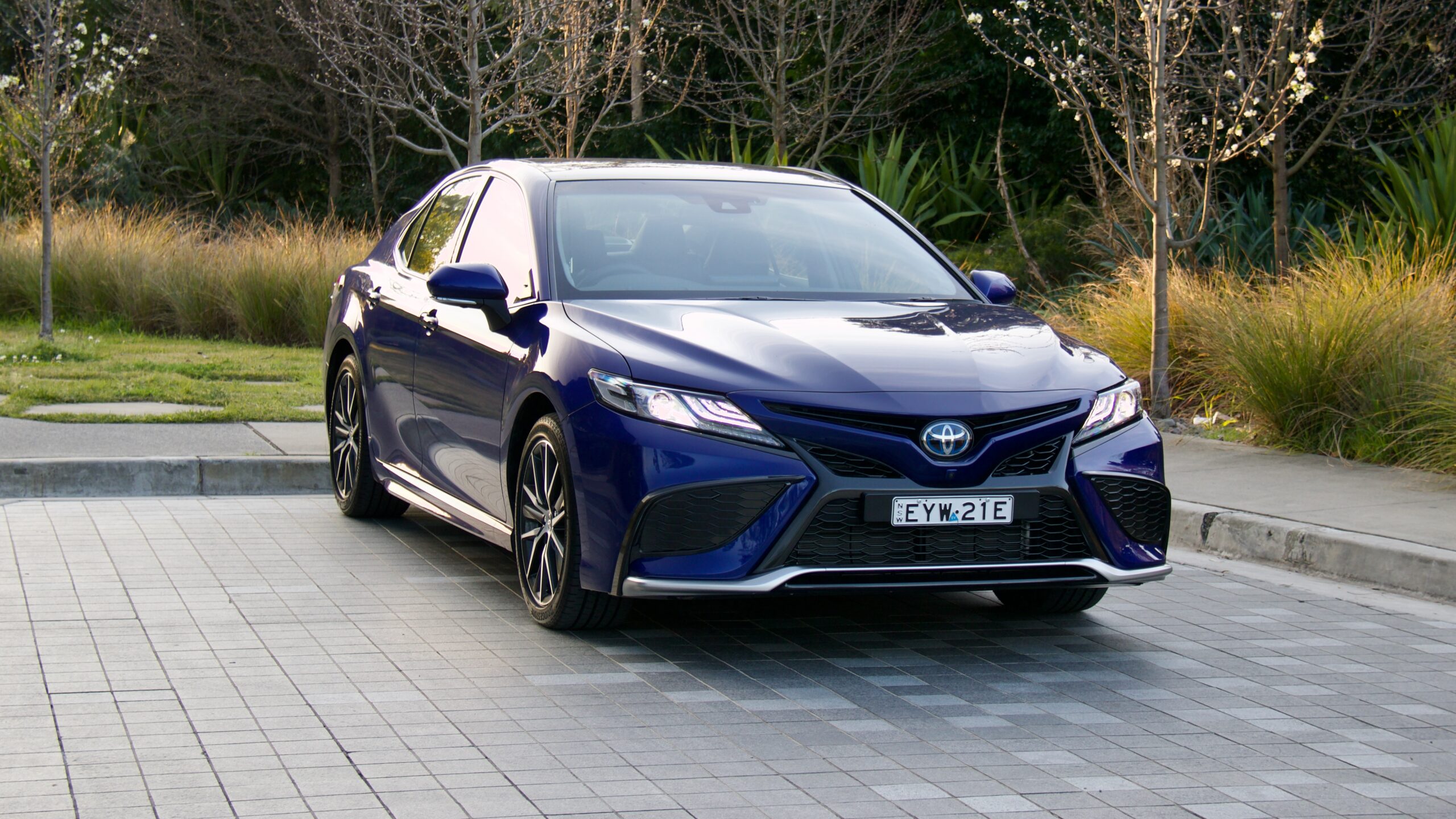
The current model Camry was introduced back in 2017, and was a big shift for the nameplate – with the end of local production, the Toyota swapped Altona production for Japan and the price rose – there was a wider range of hybrid options and an increased focus on dynamics and drivability. While Camry orders are now closed ahead of a new generation model later in 2024, this review stands as a reference for those waiting for delivery of their Camry, those looking to buy a used example and a send off to the generation that has done much to change people’s perception of what a Camry is.
How much did the 2023 Toyota Camry SL Hybrid cost to buy?
Our test car, a 2023 Toyota Camry SL Hybrid, with premium paint, sits atop of the Camry range. Prices started at $35,051 (plus on-road costs) for a base model Camry Ascent petrol sedan, up to $51,417 (plus on-road costs) – our test car (with optional premium paint) would have cost buyers $51,992 (RRP) or about $55,000 including on-road costs.
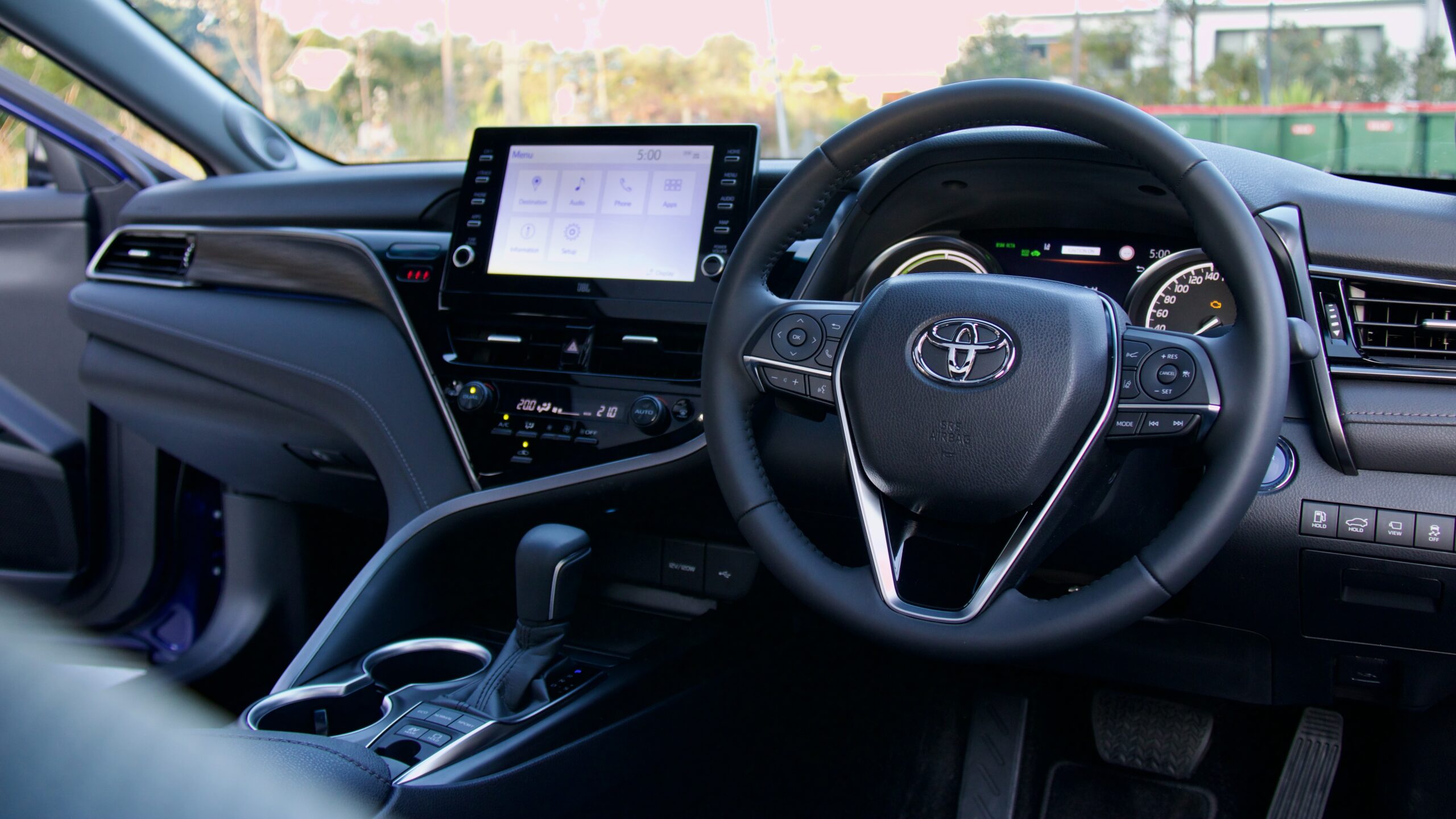
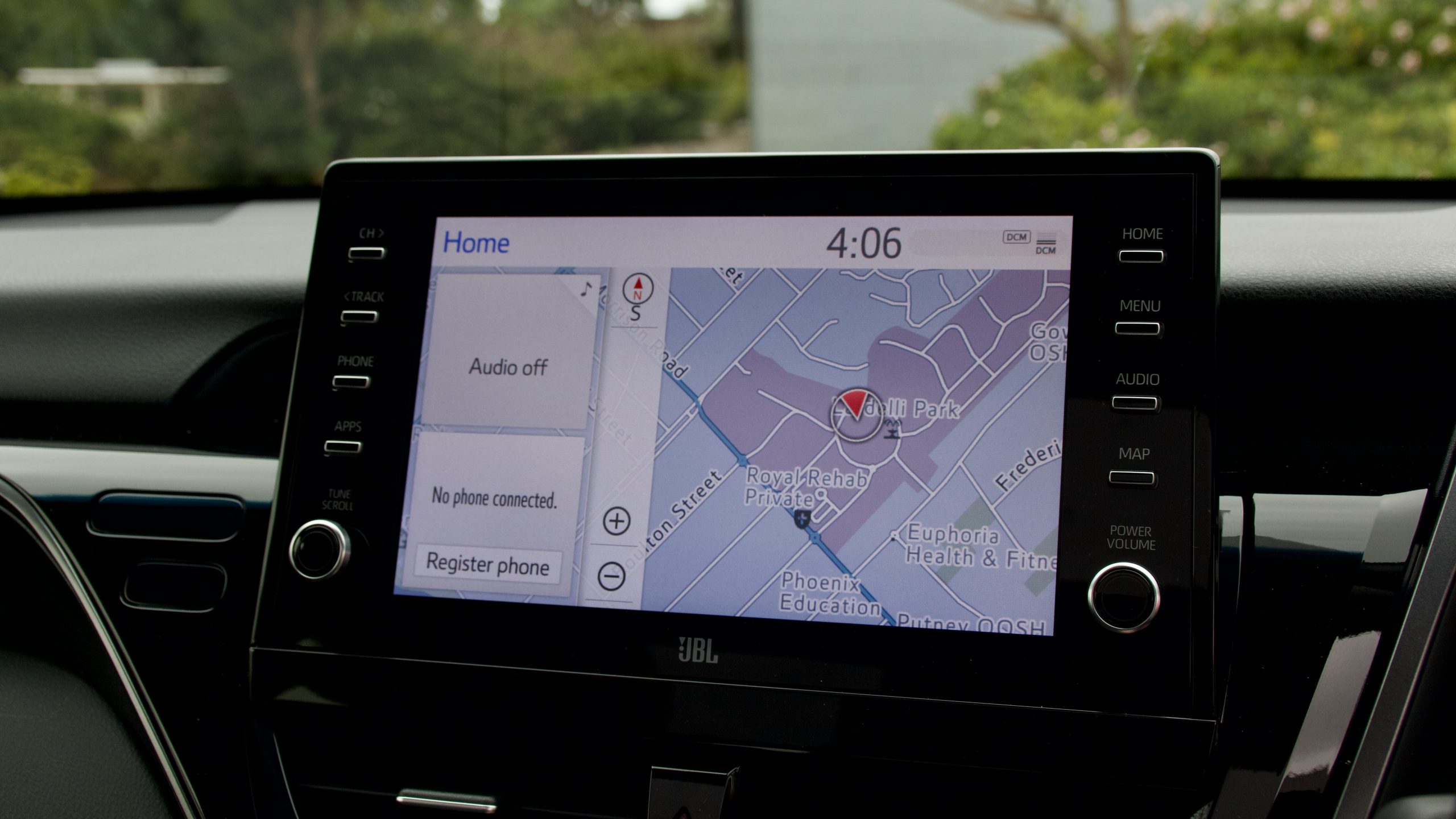
Camry SL Hybrid standard equipment:
- 18 inch Alloy wheels
- Dusk-sensing automatic LED headlights
- LED Daytime Running Lamps (DRLs)
- Automatic rain-sensing wipers
- 7.0-inch semi-digital instrument cluster
- Head-up display
- Heated and electric-folding exterior mirrors
- Power adjustable steering column
- Leather steering wheel with paddle shifters
- Panoramic glass roof
- Heated and ventilated front seats
- Leather upholstery
- Ambient interior lighting
- 10-way power driver seat adjustment with memory and 8-way power front passenger seat adjustment
- Wired Apple CarPlay and Android Auto
- Keyless entry and start
- Dual-zone climate control
- 4x USB Charging points
- 9 inch infotainment display
- AM/FM/DAB+ digital radio
- Satellite navigation
- 9 speaker JBL audio system
- Toyota Connected Services convenience features
Camry SL Hybrid safety equipment:
The current generation Camry received a five-star ANCAP safety rating in 2017, which remains applicable until December 2024 and includes the following safety equipment:
- 7 airbags (dual front, dual front side, driver’s knee, full length curtain airbags)
- Auto emergency braking (AEB)
- Lane Departure Alert with lane keeping assistance
- Automatic high beam
- Adaptive cruise control
- Road sign recognition
- Blind-spot monitoring
- Rear cross-traffic alert
- Front and rear parking sensors
- 360-degree camera
- Burglar alarm
- Toyota Connected Services (safety features)
- Stolen vehicle tracking
- Automatic collision notification
- SOS emergency call button
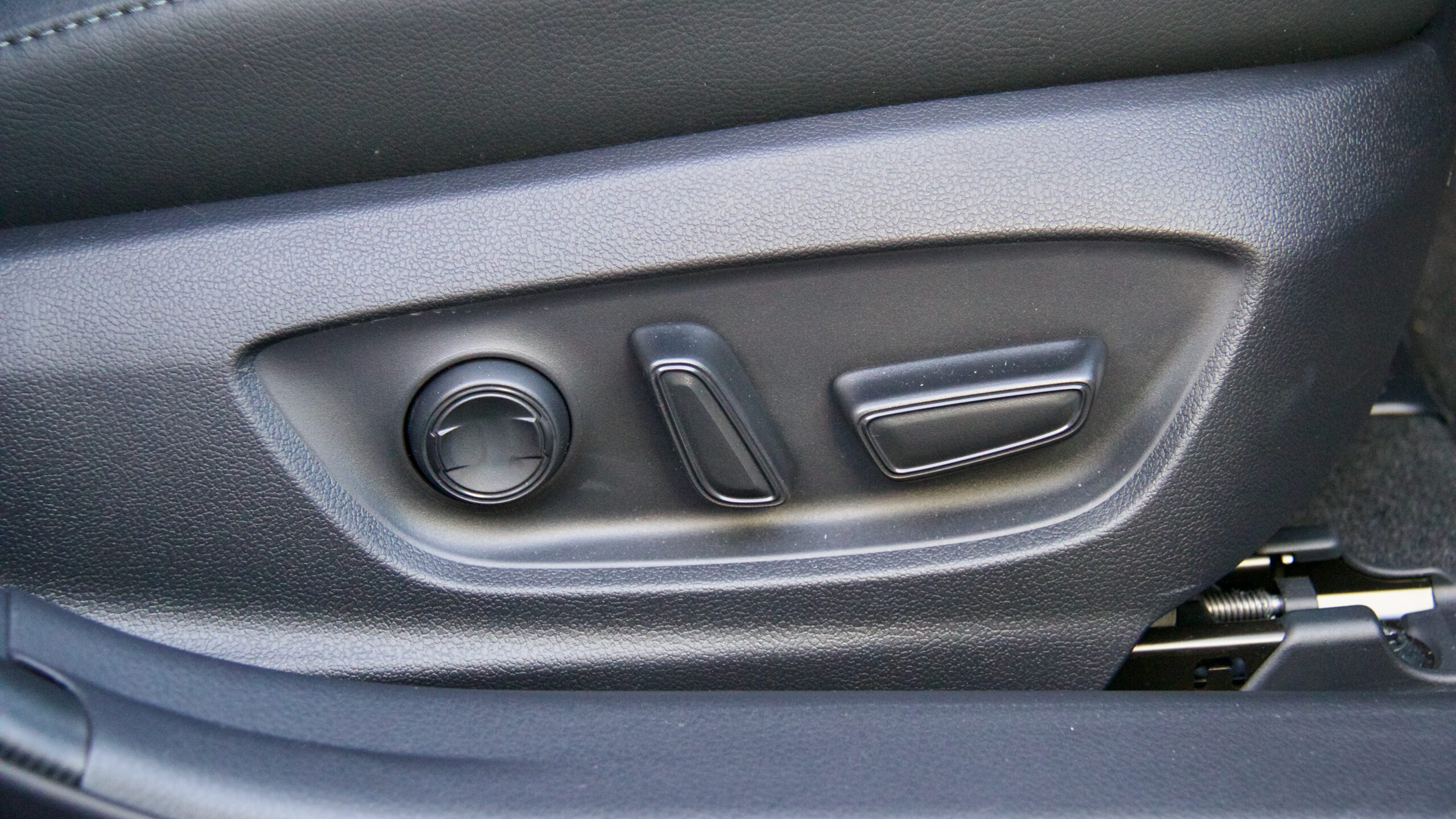
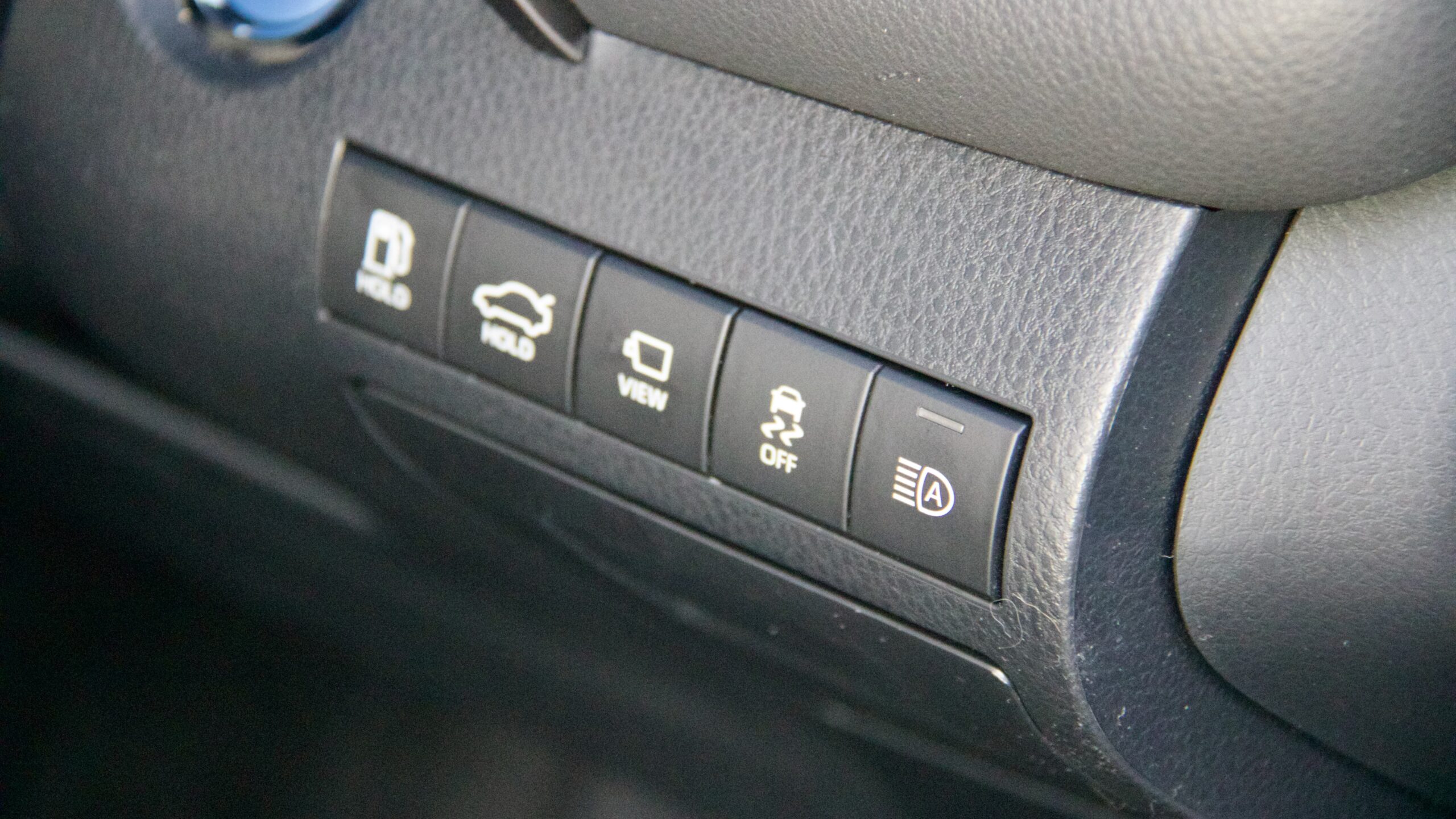
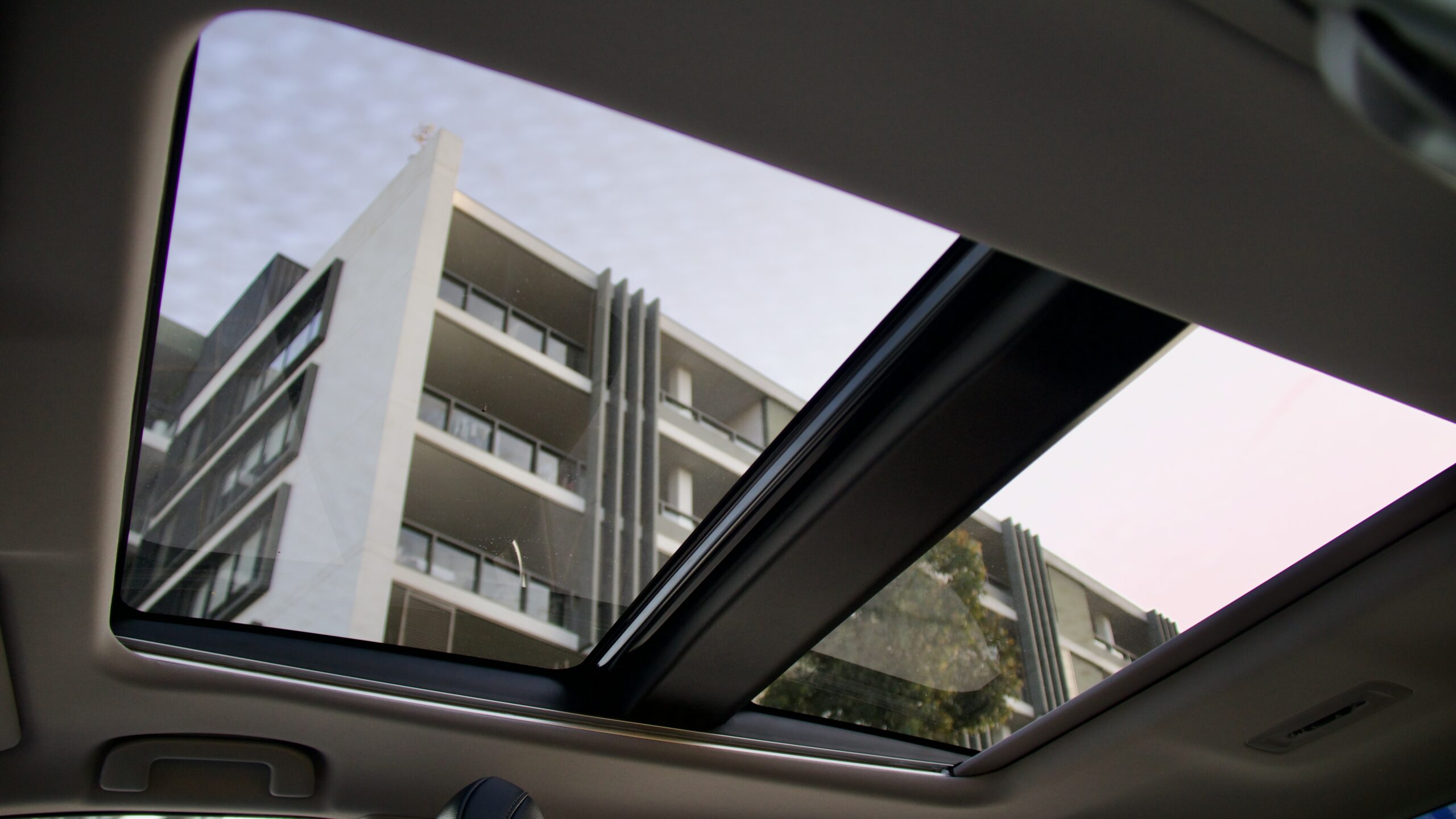
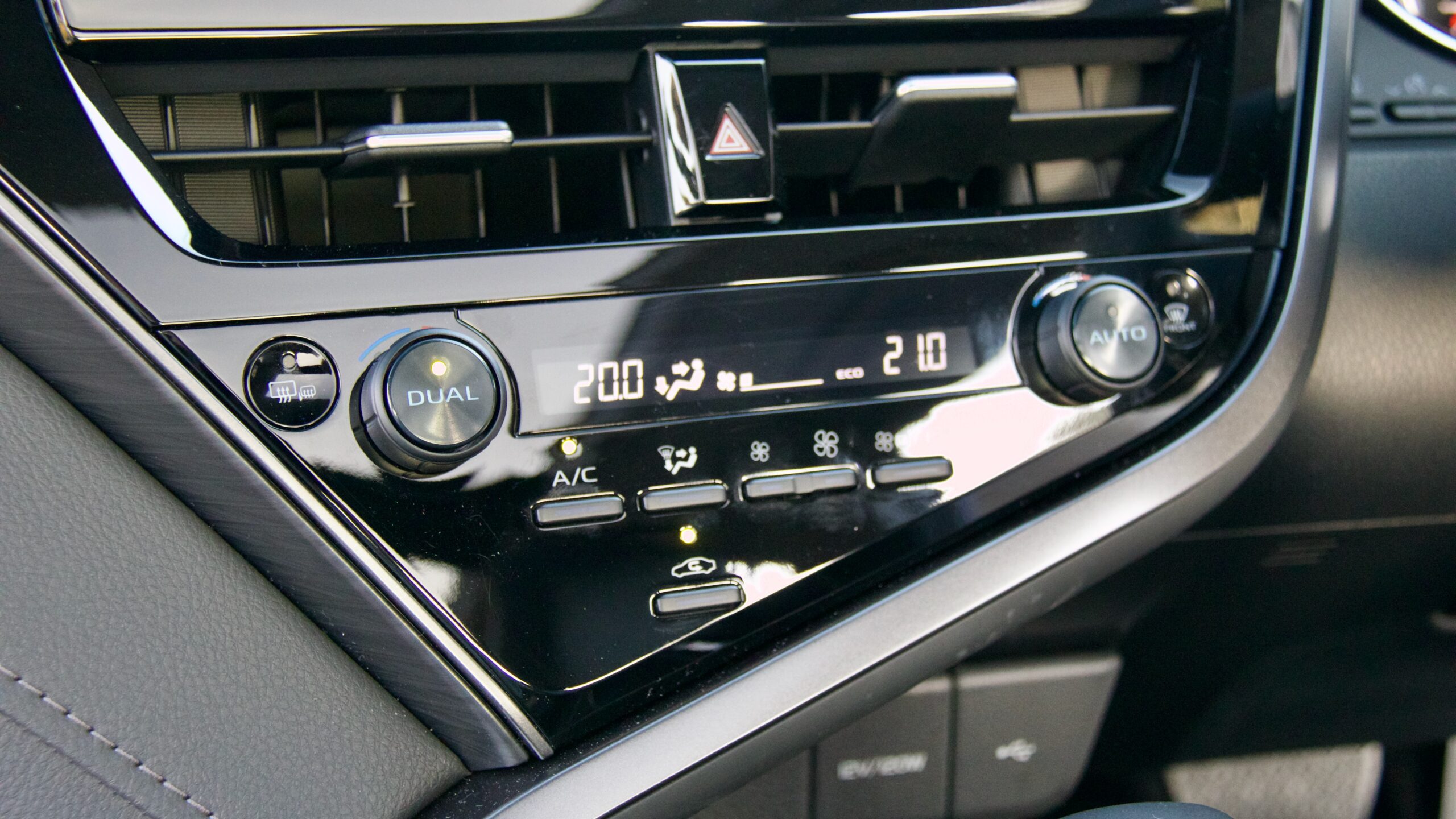
Camry SL Hybrid colour range:
Standard (no cost) colour:
- Glacier White
Premium colours (+$575)
- Lunar Blue (featured on our test car)
- Eclipse Black
- Blacksmith Bronze
- Jasper Red
- Liquid Mercury
- Silver Pearl
- Frosted White
- Glacier White
Competition to the Camry SL Hybrid is limited – there aren’t that many Hybrid sedans on the market – while the slightly smaller i30 Hybrid Sedan could be a contender, it’s only currently offered as a single specification that doesn’t match the feature set of the Camry – leaving the Honda Accord VTi-LX Hybrid as the most direct competitor to the Camry SL Hybrid. Currently in runout, the Accord is priced at $61,900 (drive away).
For the extra money, over the Camry, the Accord features front (LED) fog lights, an extra four ways of powered adjustment for the driver’s seat, an additional speaker for the sound system, tyre pressure monitoring, a driver attention monitoring system, rear automatic braking and cornering lights. The Camry counters with four-way powered adjustment for the steering wheel, a panoramic glass roof, ventilation for the front seats, ambient interior lighting, a larger 9.0-inch touchscreen (8.0-inch in the Accord), connected services including safety features (SOS emergency call, automatic collision notification and stolen vehicle tracking) and connected convenience services, road sign recognition, blind spot monitoring and a driver’s knee airbag.
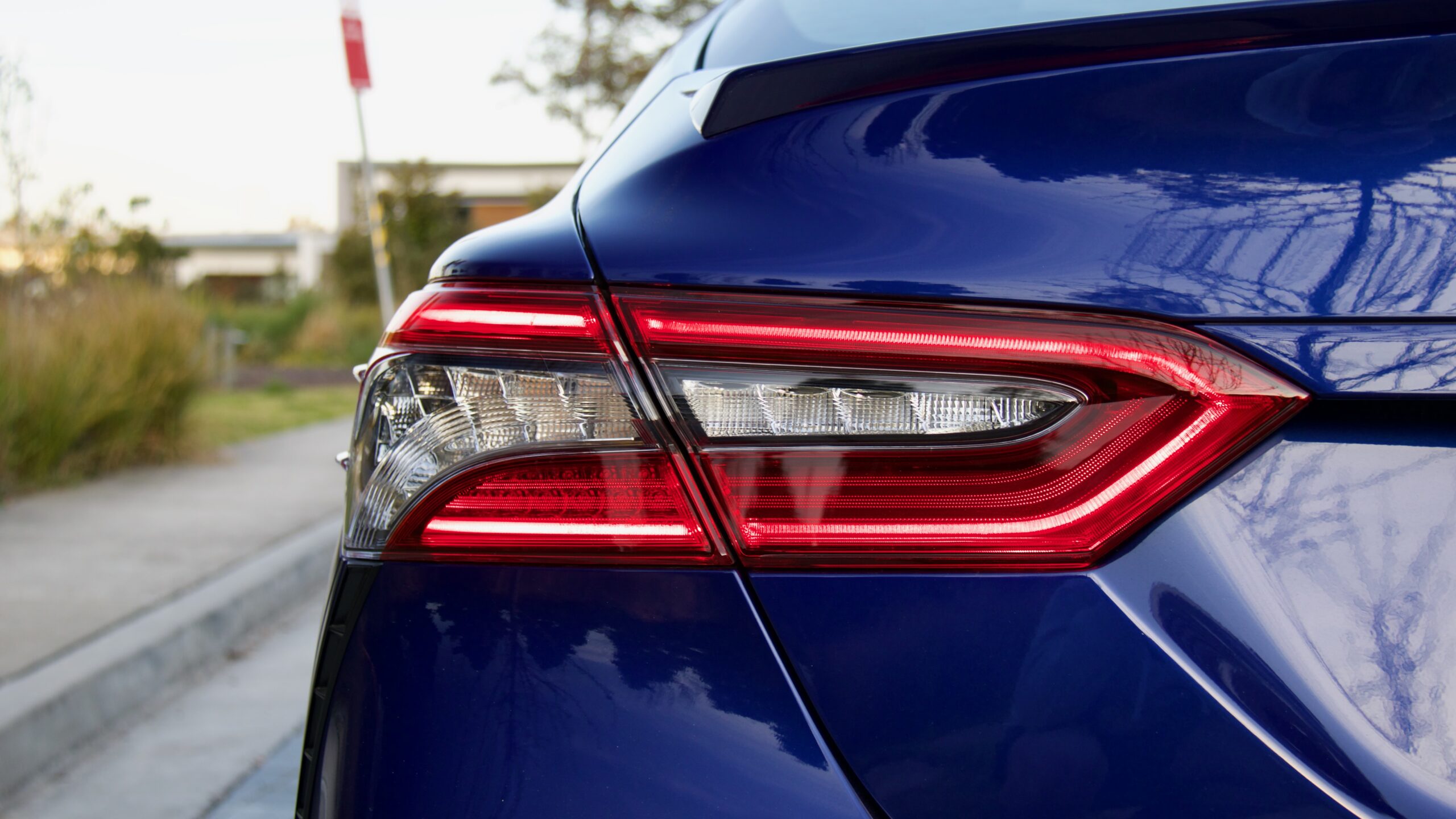
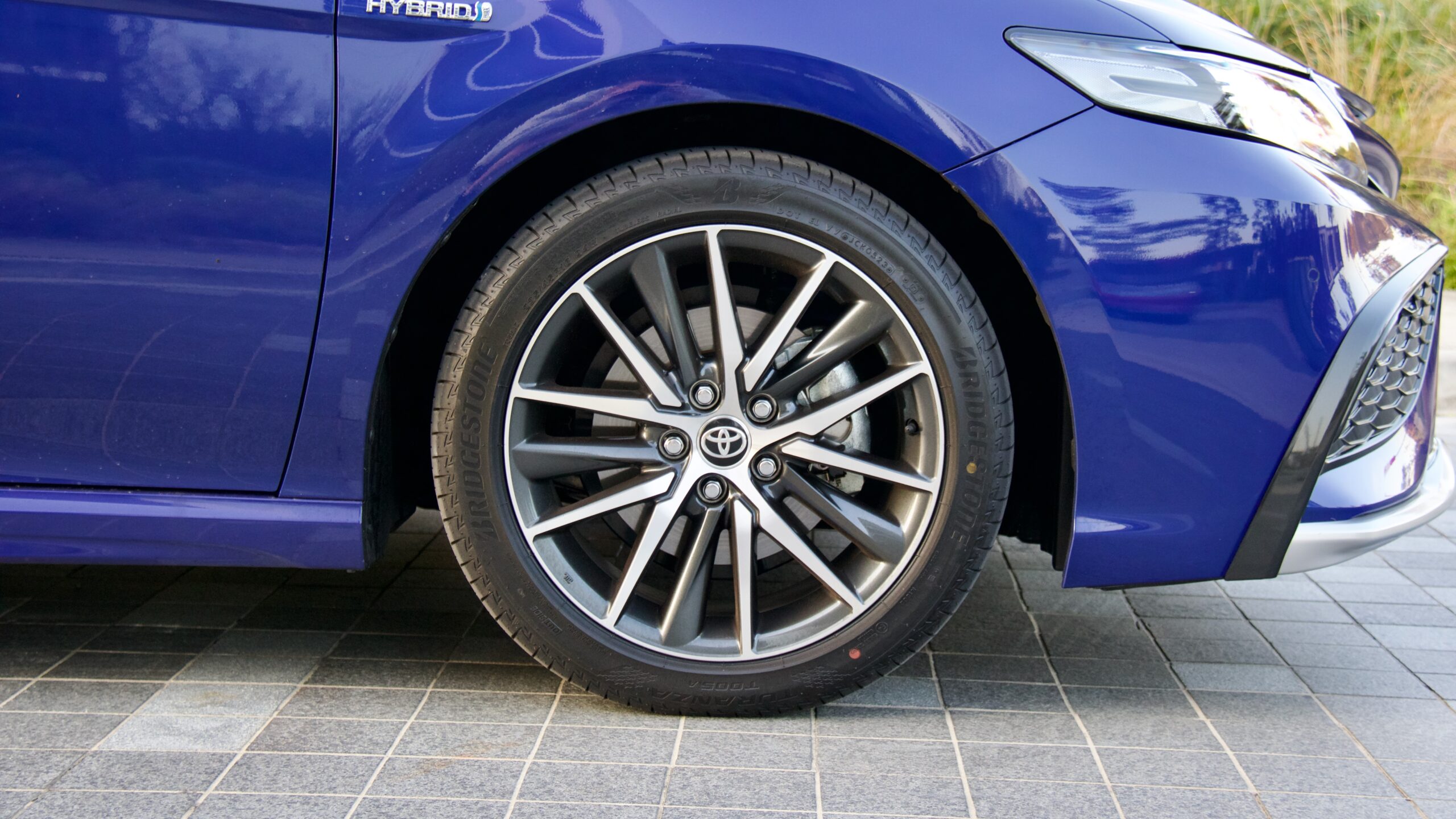
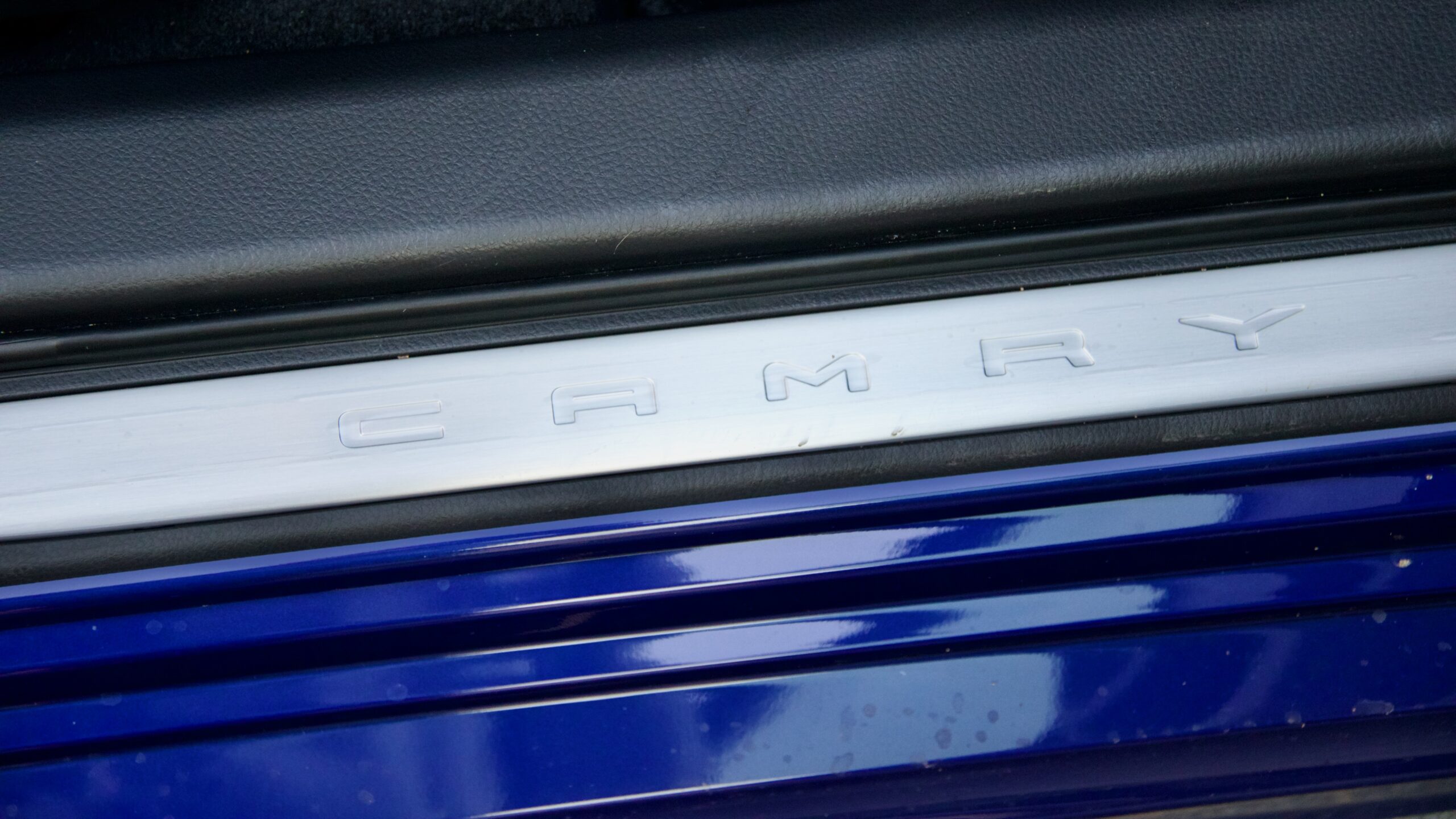
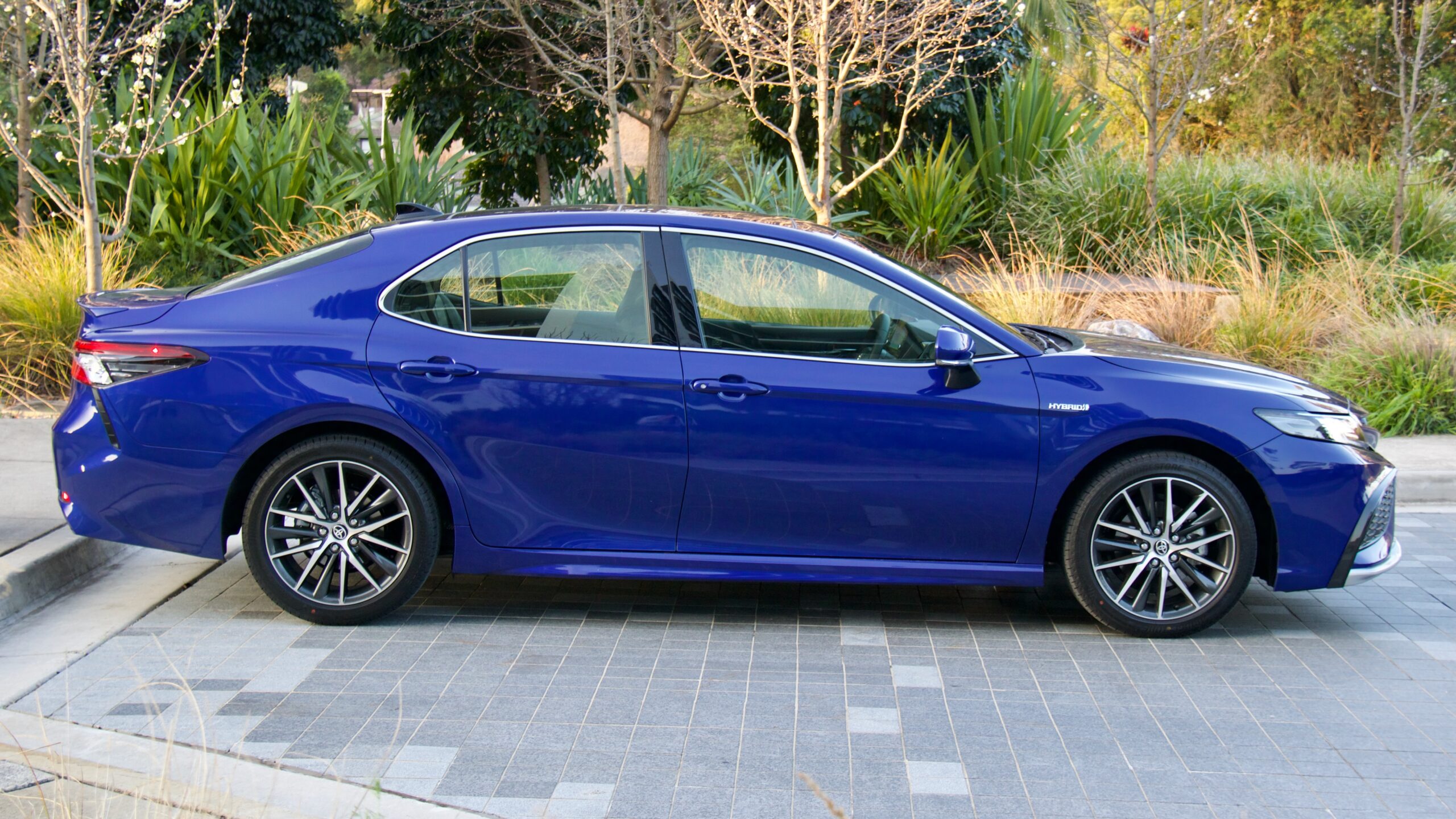
The lower price and additional features of the Camry do make it look like good value – though given the Accord is basically the only direct competitor, it’s hard to make a value comparison, and the Camry is over $10,000 more than it was when this generation was introduced in 2017. We would have also liked to have seen some extra equipment from other new Toyota products such as a digital instrument cluster, more USB points, a larger infotainment screen, wireless phone mirroring in addition to safety equipment such as rear auto breaking and front cross traffic alert. Some equipment included on overseas Camry models is also unfortunately omitted, such as air purifying technology and a number of rear seat features—including reclining and heated rear seats, a separate rear climate zone, a powered rear windscreen sunshade, door sunshades and a fold down instrument panel to control all these functions.
How fuel efficient is the 2023 Toyota Camry SL Hybrid?
The 2023 Toyota Camry SL Hybrid features a 2.5 litre petrol engine mated to electric motors and a battery – essentially the same drivetrain this generation of Camry debuted with back in 2017, albeit the Nickel Metal Hydride was swapped for a lithium battery in 2021 – though this isn’t necessarily a bad thing. The 2.5 litre Atkinson Cycle engine produces a maximum 131kW of power at 5700rpm and 221Nm of torque between 3,600rpm and 5,200rpm – combined with the two electric motors, total system power output is a healthy 160kW.
There isn’t much to say about the drivetrain that hasn’t already been said – it’s still of the best hybrid systems money can buy, even if it’s getting on in years. It’s got more than enough power around town and also to get up to highway speeds. The instant torque from the electric motors livens things up at lower speeds, and we were never left wanting for more power. The Camry isn’t a performance car, and wasn’t designed to be, though we think most of the target market will be more than happy with the around 8.0-second 0-100km/h sprint time.
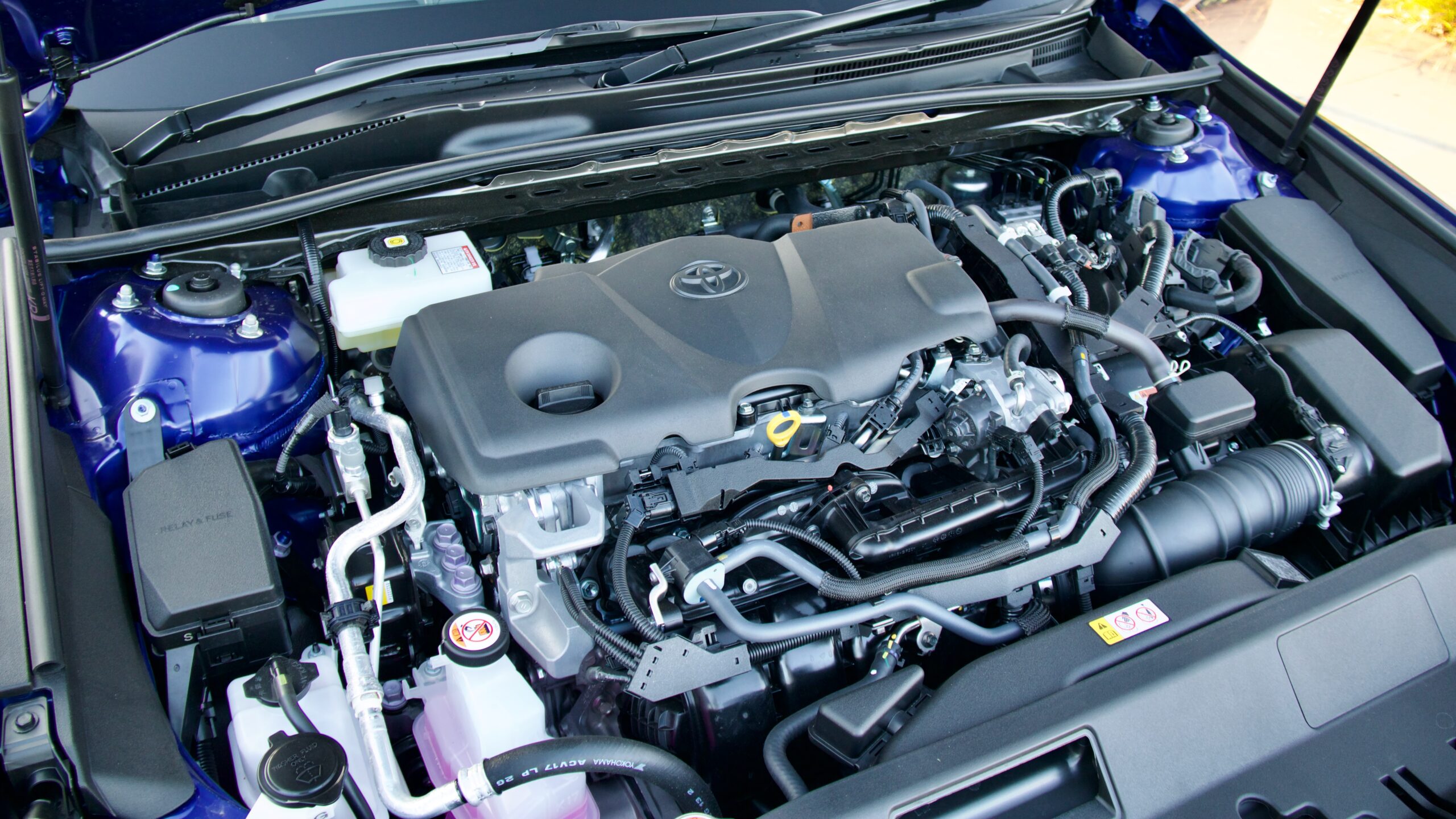
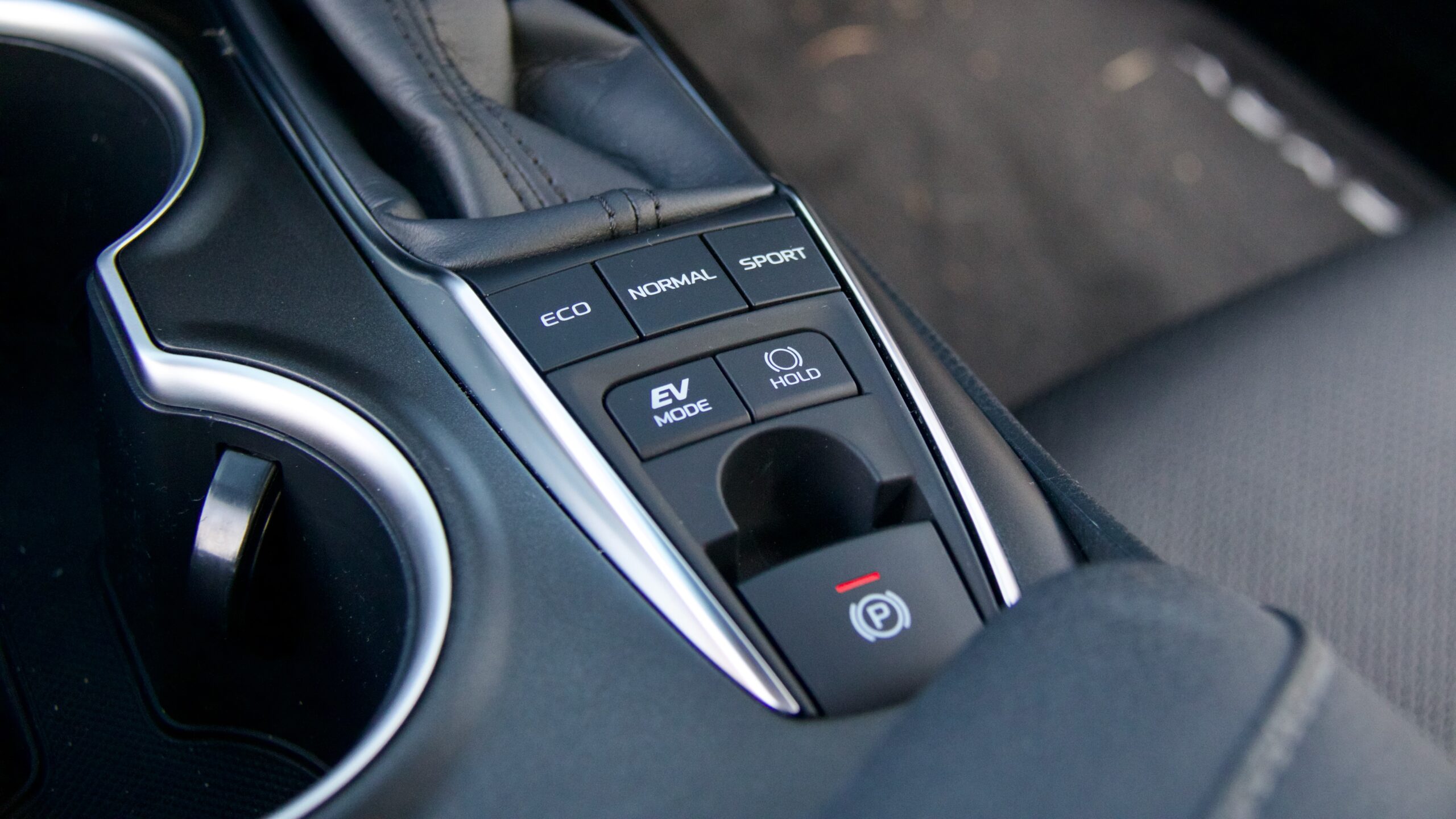
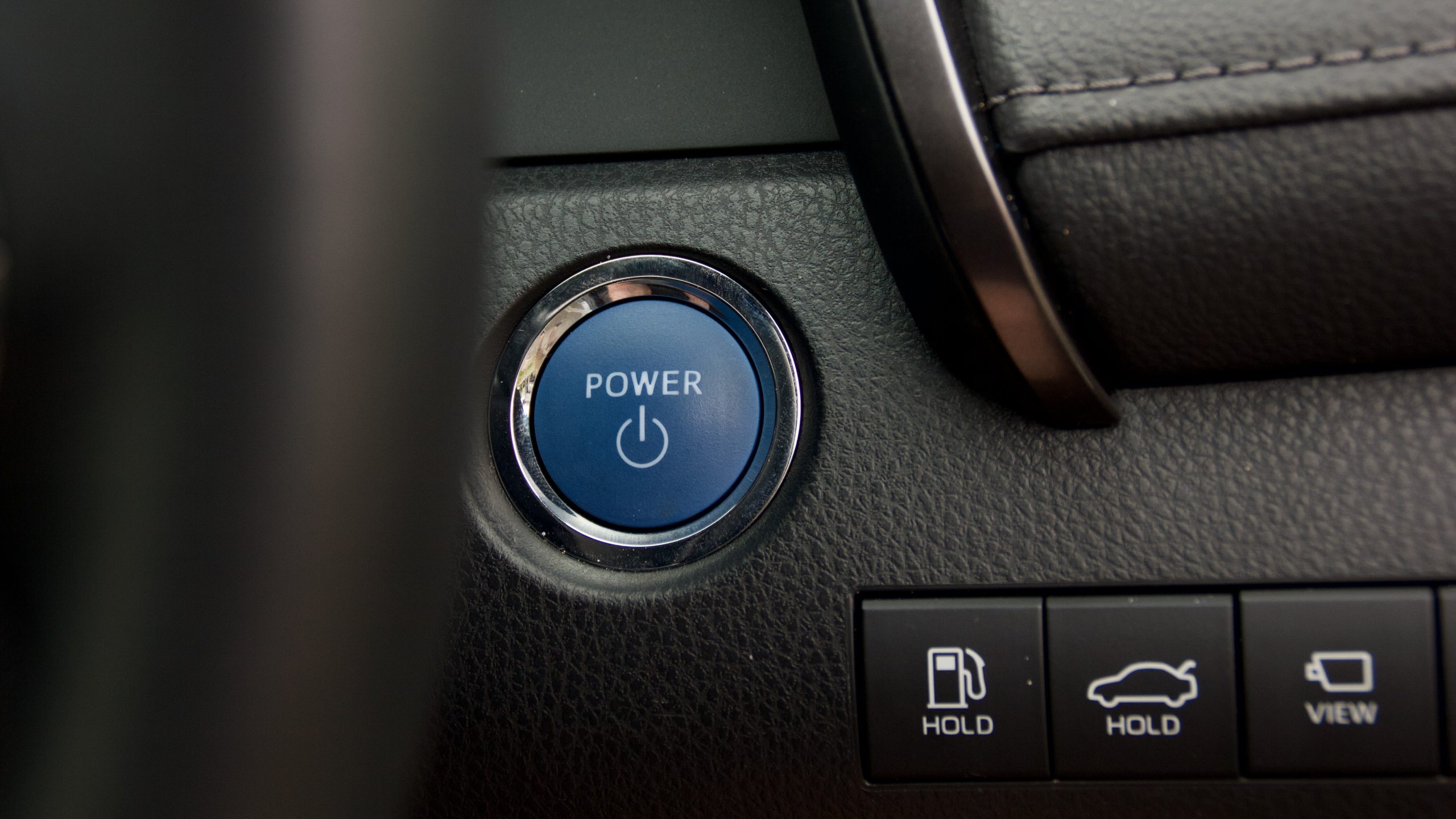
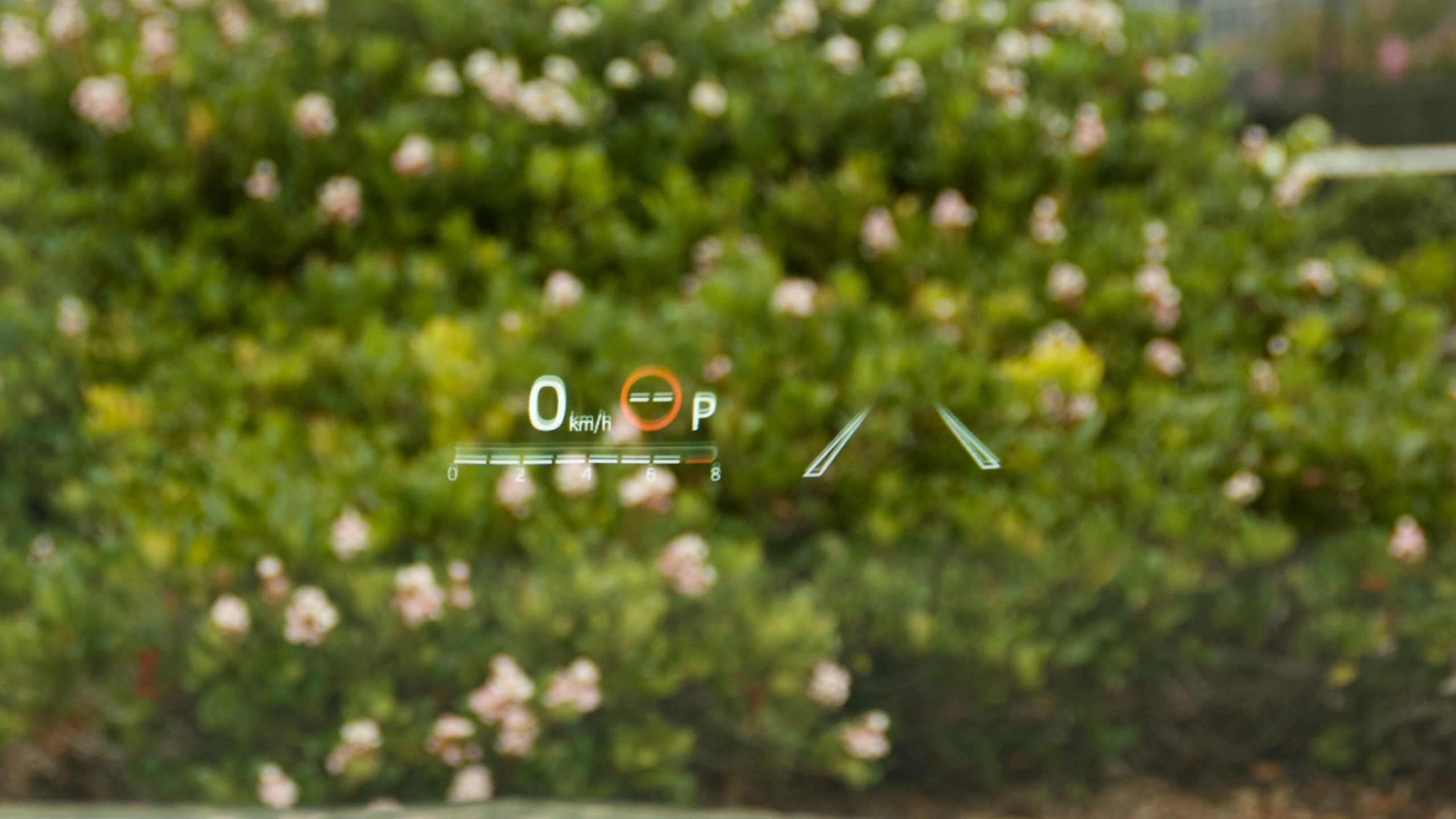
The E-CVT transmission that Toyota uses isn’t the first word in liveliness – it’s a system setup to eke out the absolute best fuel economy, rather than provide an engaging drive. It also manages combining both power sources as well as the transitions between them with aplomb – the change from electric to petrol and back again are only ever slightly perceivable in sound. The only time the transmission becomes unsavoury is on heavy acceleration where the ‘CVT’ in ‘E-CVT’ becomes apparent – harsh accretion drones and a bit buzzy – but at all other times the drivetrain is quite civilised.
As a general rule we’ve found that while competitors offer drivetrains which are more engaging and offer better refinement under harsh acceleration, Toyota, with it’s nearly 30 years of experience building hybrids, still manages to beat the competition on fuel efficiency – most other hybrids we’ve tested produce respectable economy, however, as in the 2023 Camry SL Hybrid’s case, the compromises in drivability bring stellar economy.
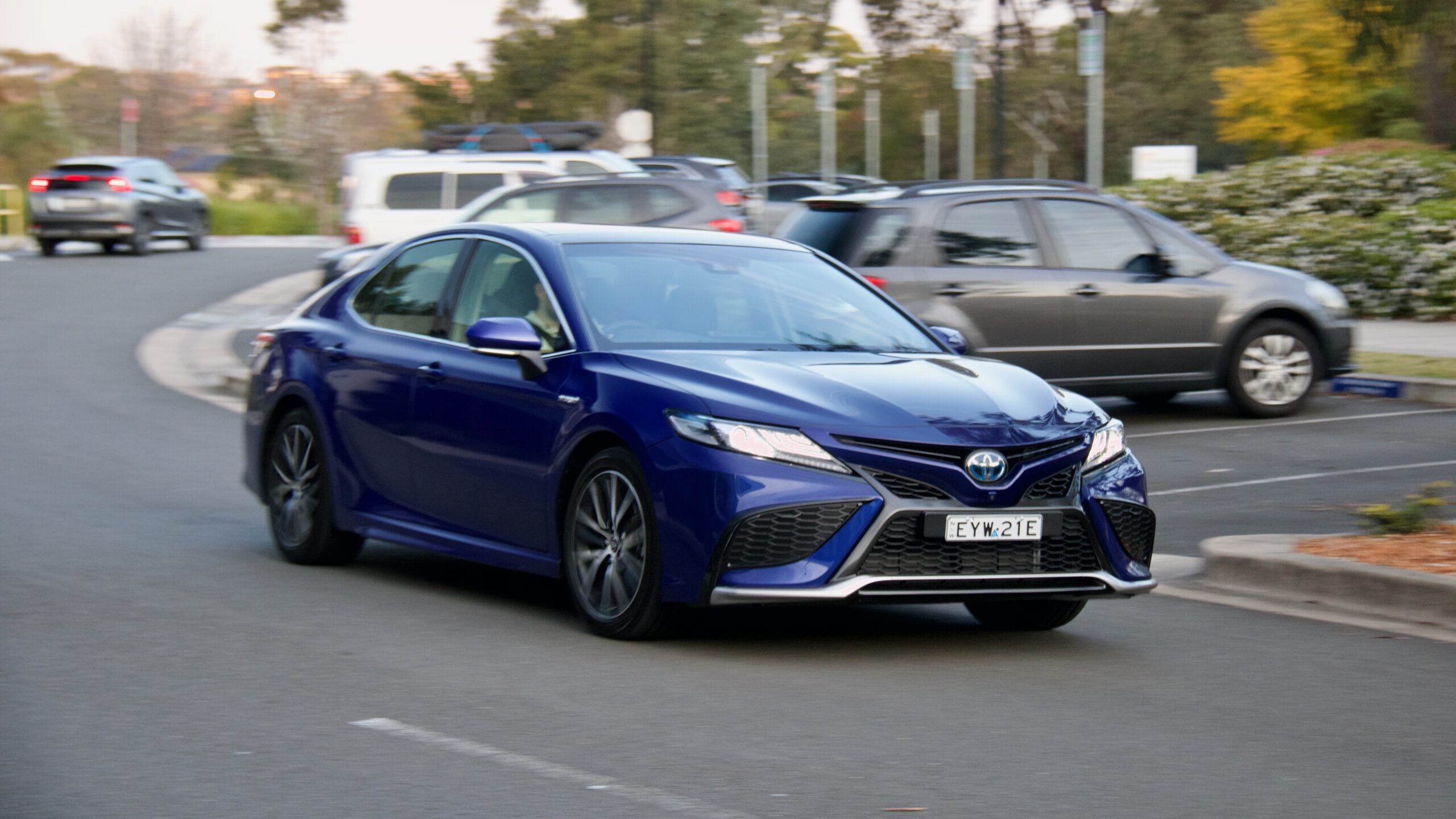
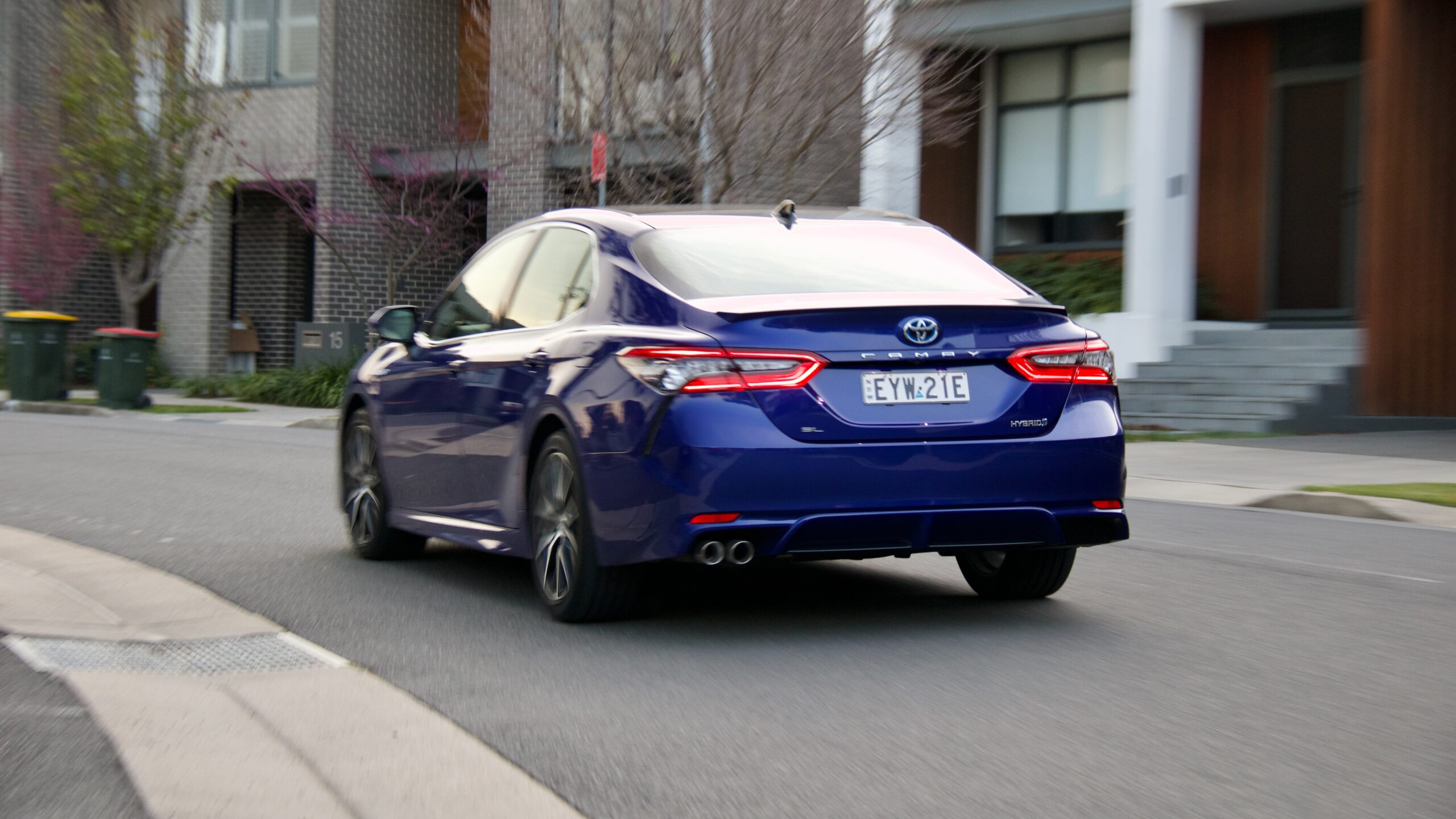
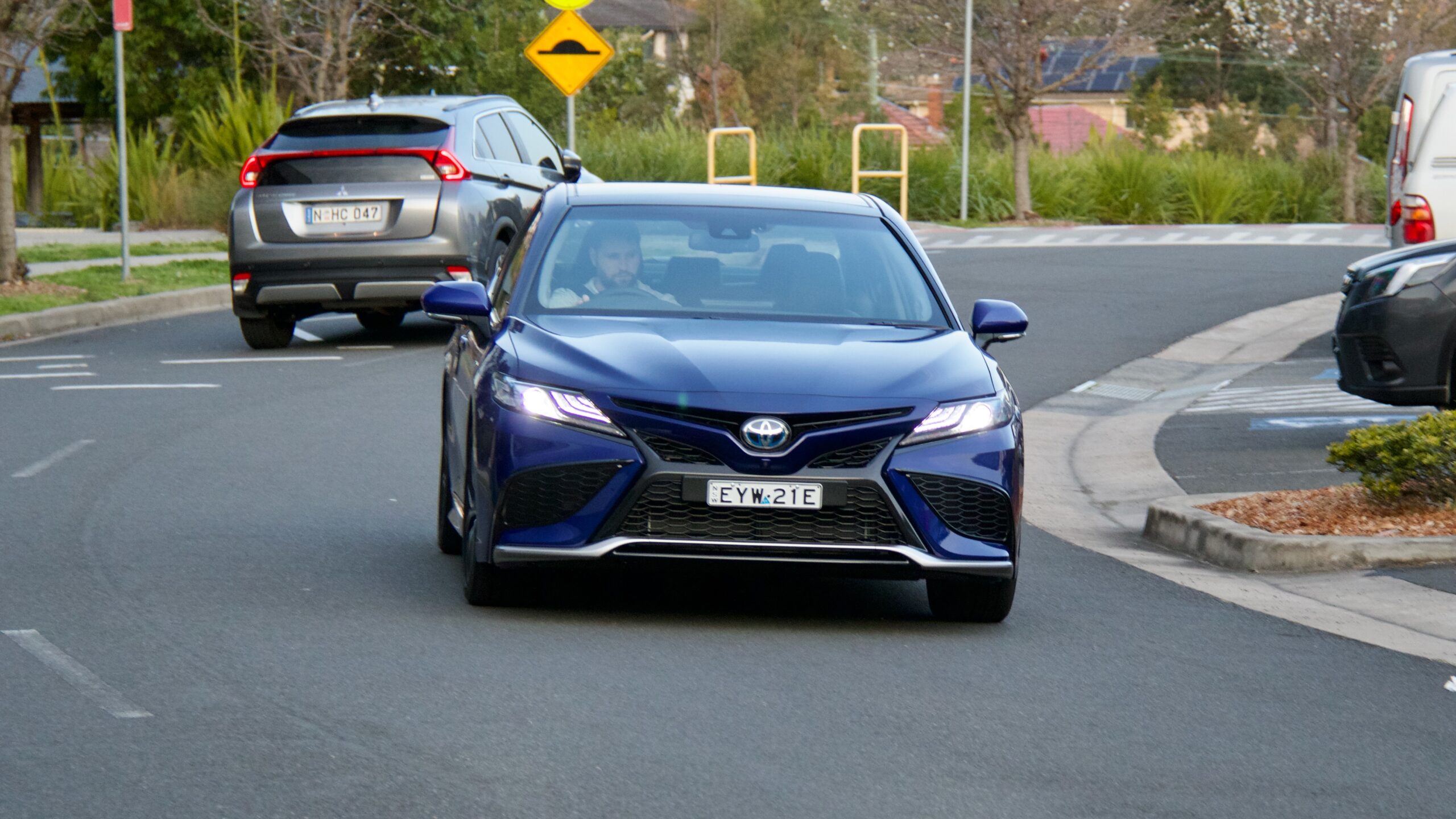
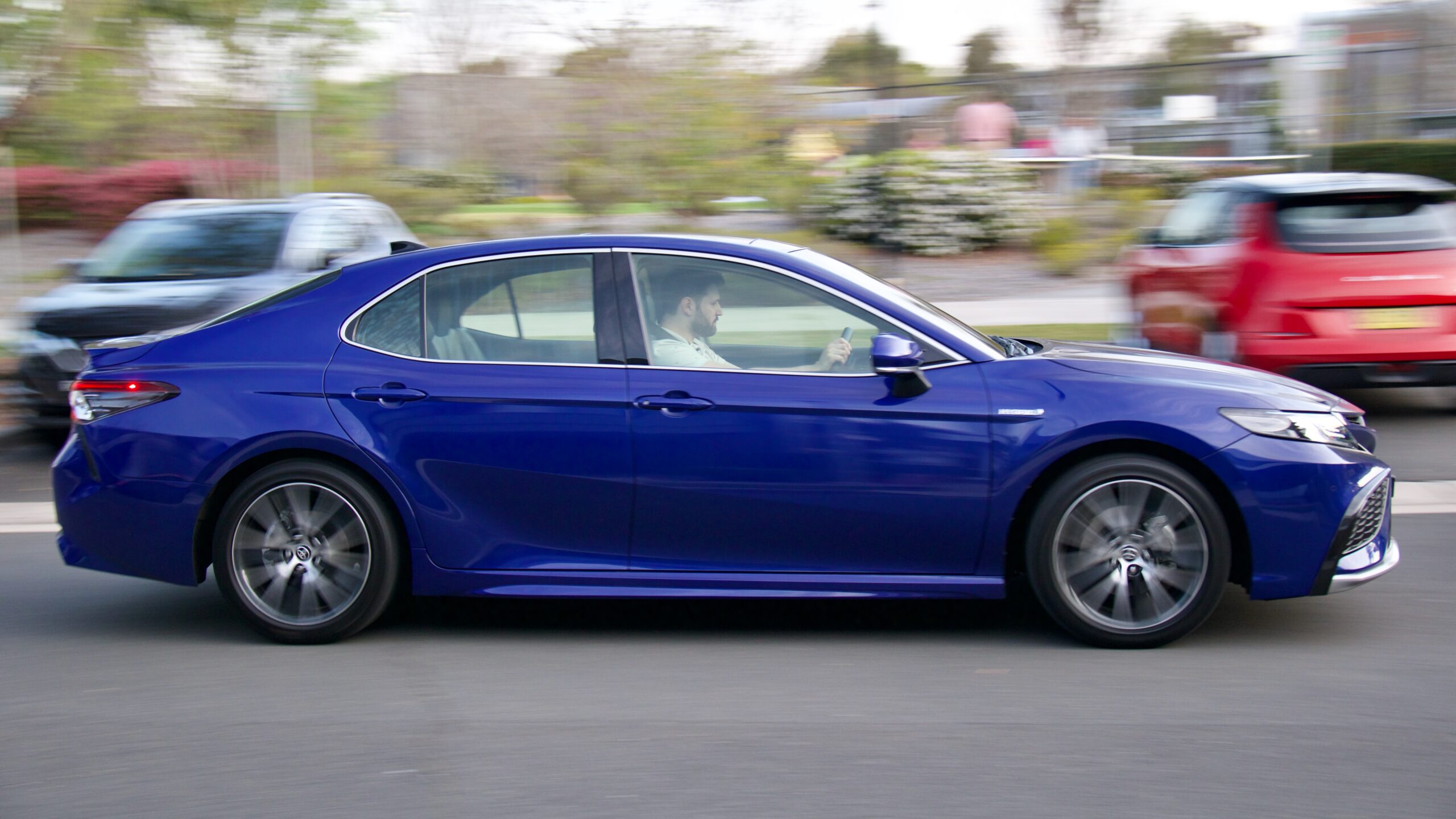
Toyota says the 2023 Camry SL Hybrid uses 4.5L/100km on the combined cycle and we achieved 5.2L/100km across our week with it, which still a pretty commendable job if you ask us, given our driving was involved a fair bit of highway driving where hybrids are at their least efficient. Unfortunately, the Camry requires at least 95 octane fuel which will put the price up a bit for drivers. With a full 50-litre fuel tank and while achieving the same fuel economy we achieved across our week, a range of around 980kms should be achievable on a single tank of fuel.
How does the 2023 Toyota Camry SL Hybrid drive?
Traditionally, Camrys were known for their driving comfort and safe handling, but not for their dynamism – being one of the early recipients of Toyota’s TNGA platform which was designed with handling ability in mind, this generation Camry is a different beast. The 2023 Camry SL Hybrid retains the comfort and safe feeling of previous generations, but adds a new found maturity and handling ability.
We were impressed by the steering tune Toyota has given the Camry. It’s well weighted, with a good balance of having feeling, being direct but also being light enough to make manoeuvring around easy – given the Camry is bigger and heavier than ever, this is appreciated. Even with larger 18-inch alloys, the 2023 Camry SL Hybrid rides well – driving is a serene experience with the cabin being insulated from most of what our subpar roads can throw at it. Tyre roar is well suppressed, as is wind noise – things are fairly quiet even at highway speeds. The suspension tune is great with excellent absorption of bumps, poor road surfaces and pretty much everything that’s thrown at it.
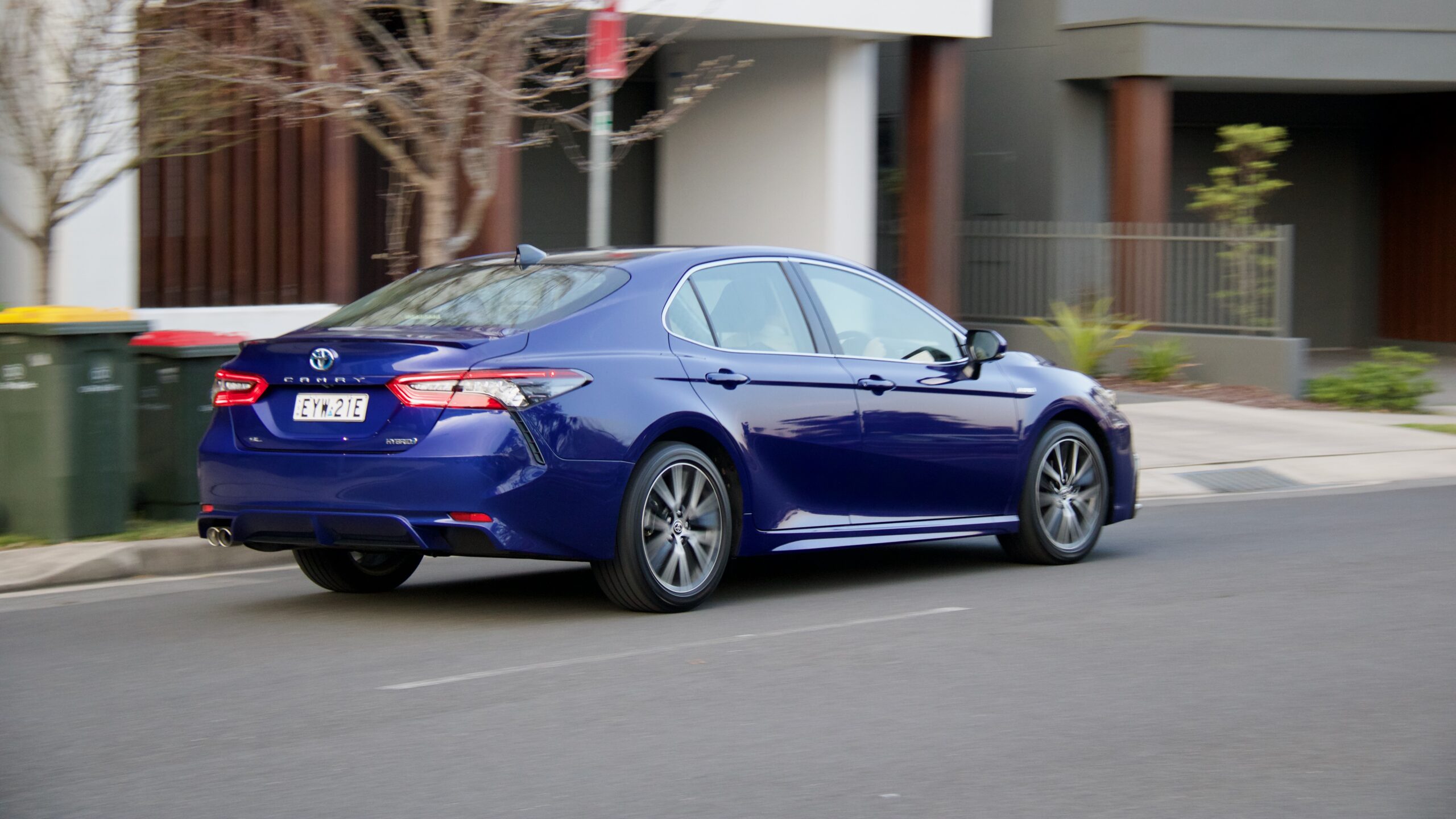
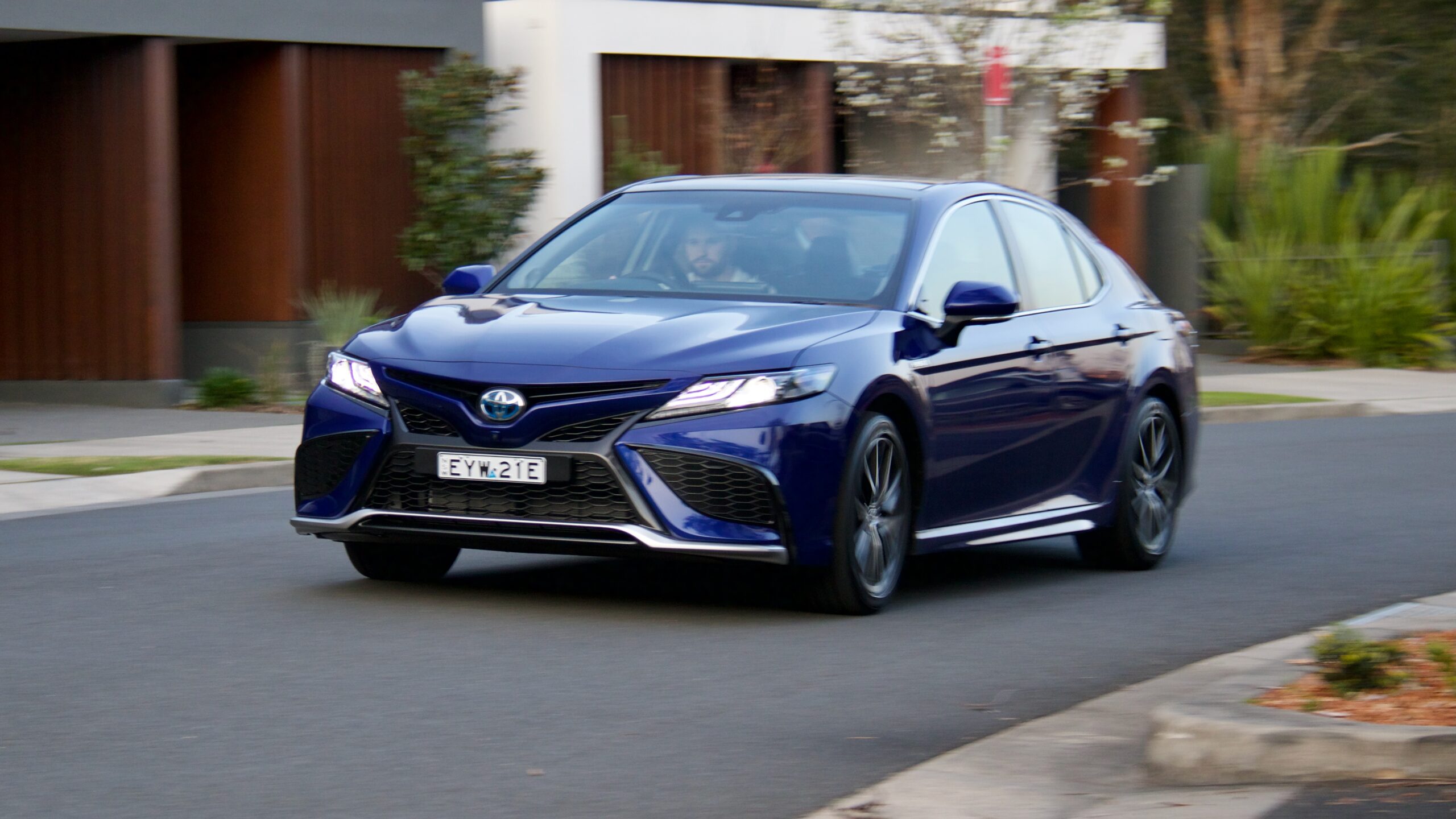
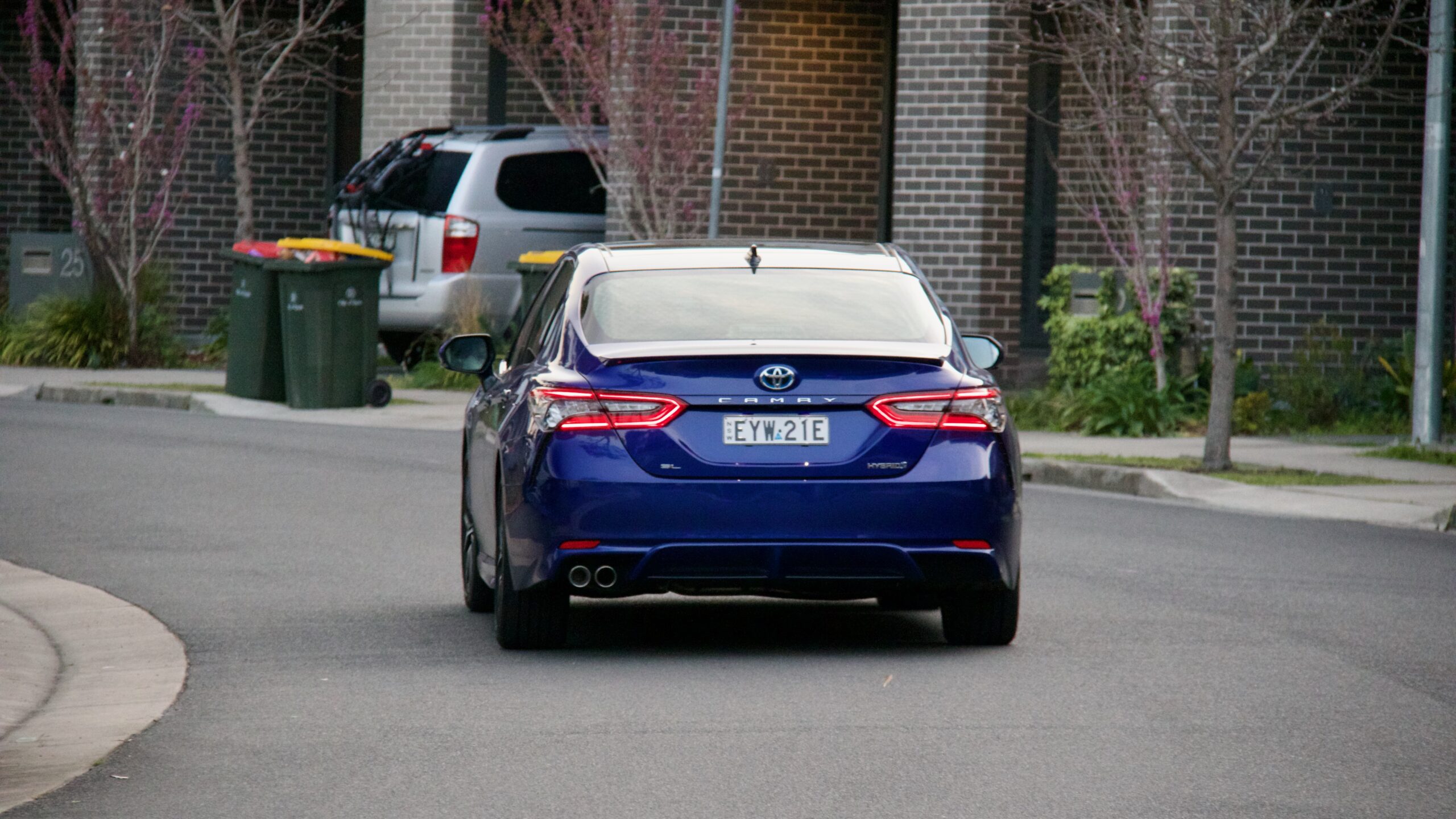
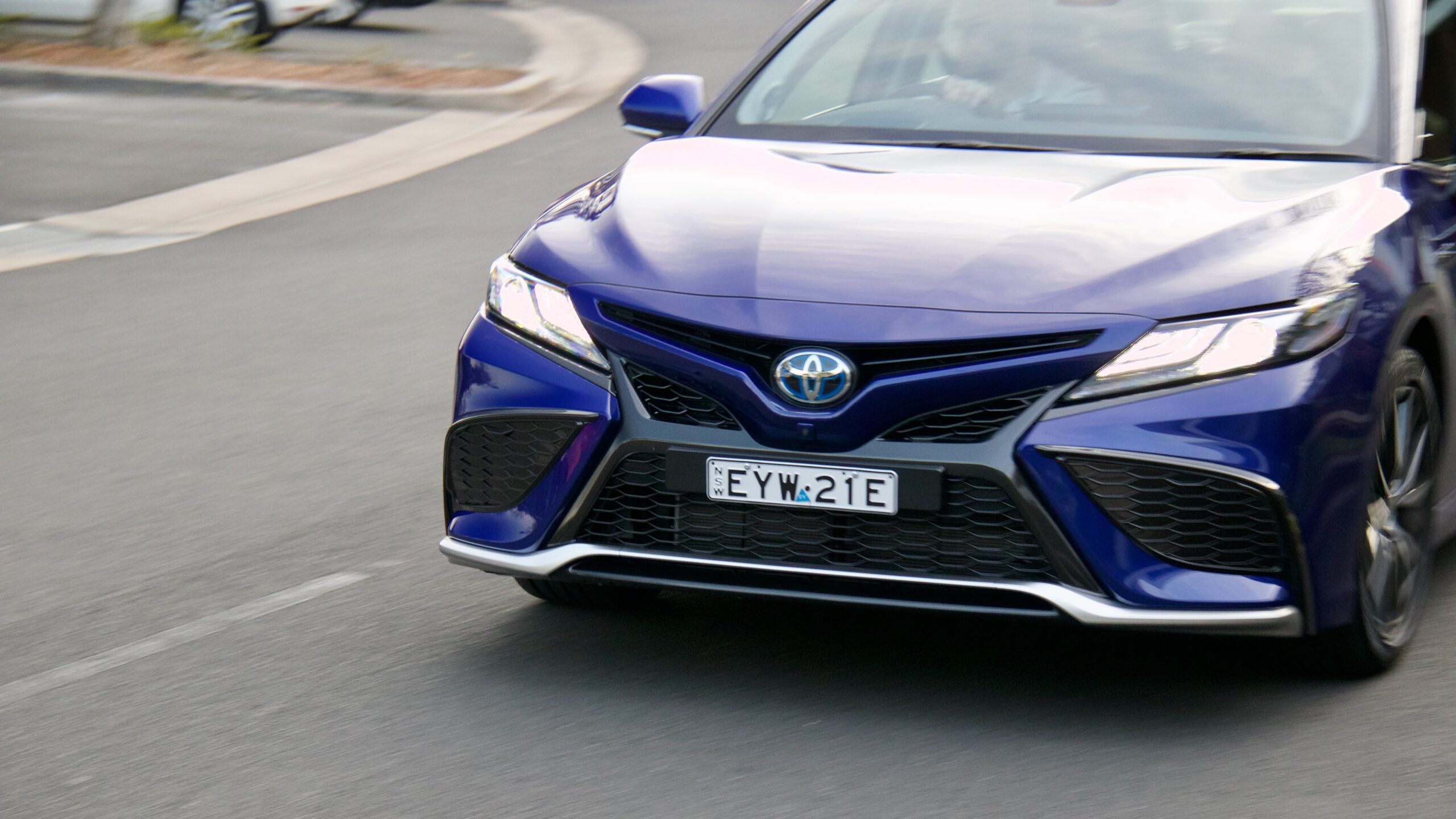
In contrast to the serene nature, as we’ve discovered before, the current Camry can be thrown around corners faster and harder than pretty much any other car which has worn the nameplate. It sticks to the road around corners and you can have a bit of fun pushing it into corners, the boat like feel and understeer of previous generations is nowhere to be found. Most buyers won’t push a Camry anywhere near this hard, but as always they will appreciate its comfort and sure footed nature – everyone benefits from a good package in some way.
Visibility in the 2023 Toyota Camry SL Hybrid is great – with good sized side mirrors, a good view out the back and the sides of the car. The reversing and 360 degree cameras do help, but they’re unfortunately quite grainy and dated – they’re serviceable but Toyota’s more recent vehicles have much better setups. Most of the driver assistance systems work well and aren’t too obtrusive.
How practical is the 2023 Toyota Camry SL Hybrid?
The interior of the 2023 Toyota Camry SL Hybrid is fairly similar to the one that debuted back in 2017 – the 2021 revision did rearrange the location not the infotainment screen, but not much else has changed. The interior is pleasant, but perhaps a touch dated – the driver centric front curved centre console and dash adds some interest to the interior and there are ‘wood’ trim and ‘metal’ inserts in a few places to liven things up, however most of the design is conservatively grey and black – it’s smart and fairly modern and overall a pleasant place to be. Material quality is good, though it’s not Mazda quality – we do wish Toyota would put a little more effort into materials, it would lift the ambience of the space. Still, there are plenty of soft touch materials throughout, and all of the switchgear is excellent – well dampened and precise.
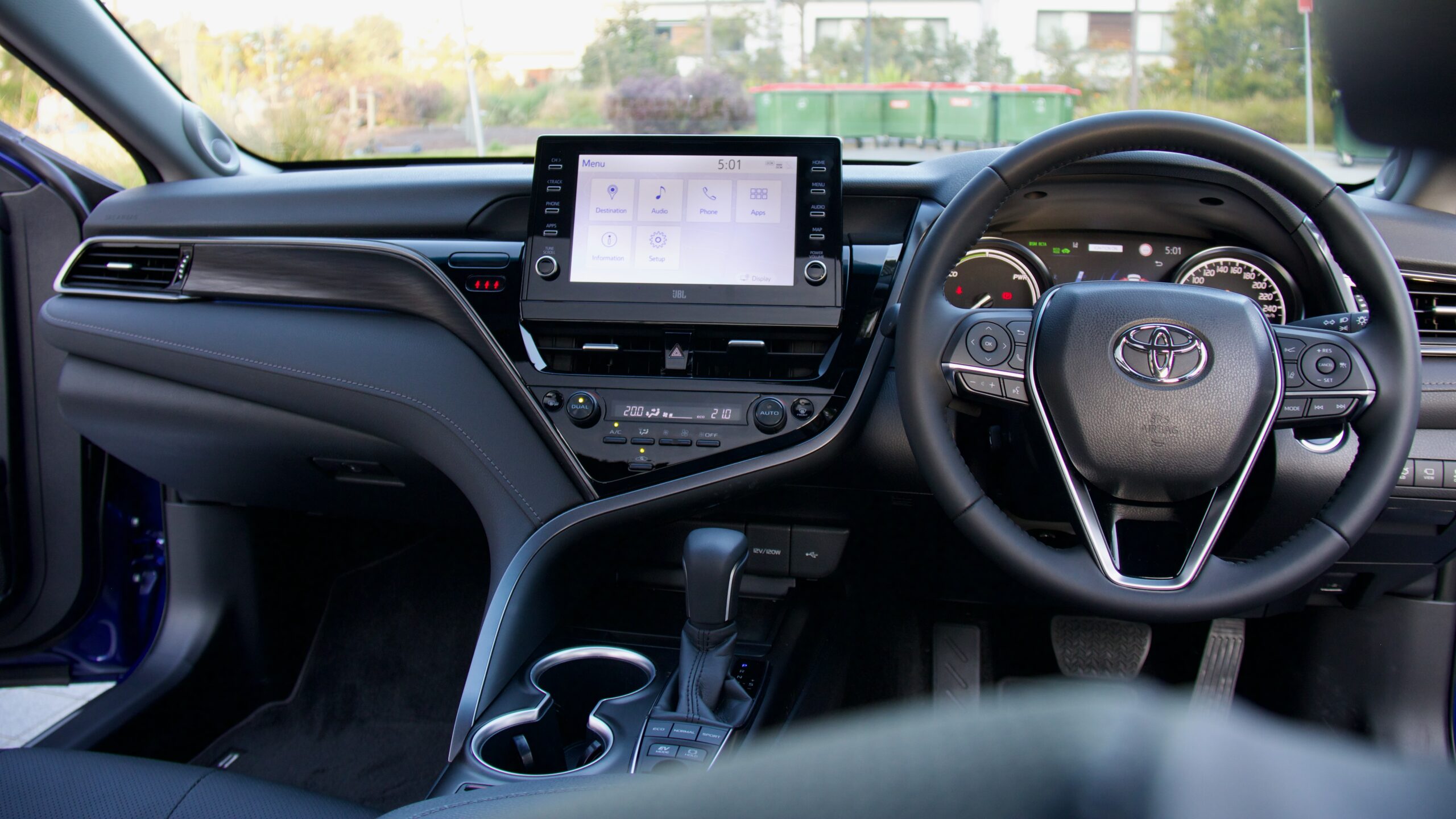
The front seats are comfortable to sit in, though a bit more bolstering would be nice for extra support. Finding a comfortable position in either seat isn’t hard, with 10 ways of powered adjustment (including lumbar) for the driver. Taller drivers may struggle though, with the panoramic sunroof eating into driver headspace. The seats themselves are upholstered in leather, which again isn’t the most luxurious implementation of leather ever, but still feels nice under hand. Seat heating and ventilation is helpful for keeping front row passengers in comfort all year round. In true Toyota style, there is an abundance of storage throughout the cabin, with a large centre console storage box, a phone closable cubby in front of the gear shifter, large cupholders and useful door pockets
Infotainment in the Camry is provided by a 9.0-inch touchscreen, mounted in a tablet style above the dash. Although updated in 2021, it is unfortunately one of the most dated aspects of the Camry, with somewhat clunky last generation Toyota software and screen resolution which is passable, rather than a joy to look at. There are still wired Apple CarPlay and Android Auto, which often bypasses the need to use the outdated Toyota software anyway. We would have liked Toyota to have upgraded the screen to the same consistently excellent screen and software that has been rolling out since 2022 – buyers will have to wait for the next generation Camry for this. Sound from the premium JBL speaker system is reasonable, but we’d expect better from a premium branded system.
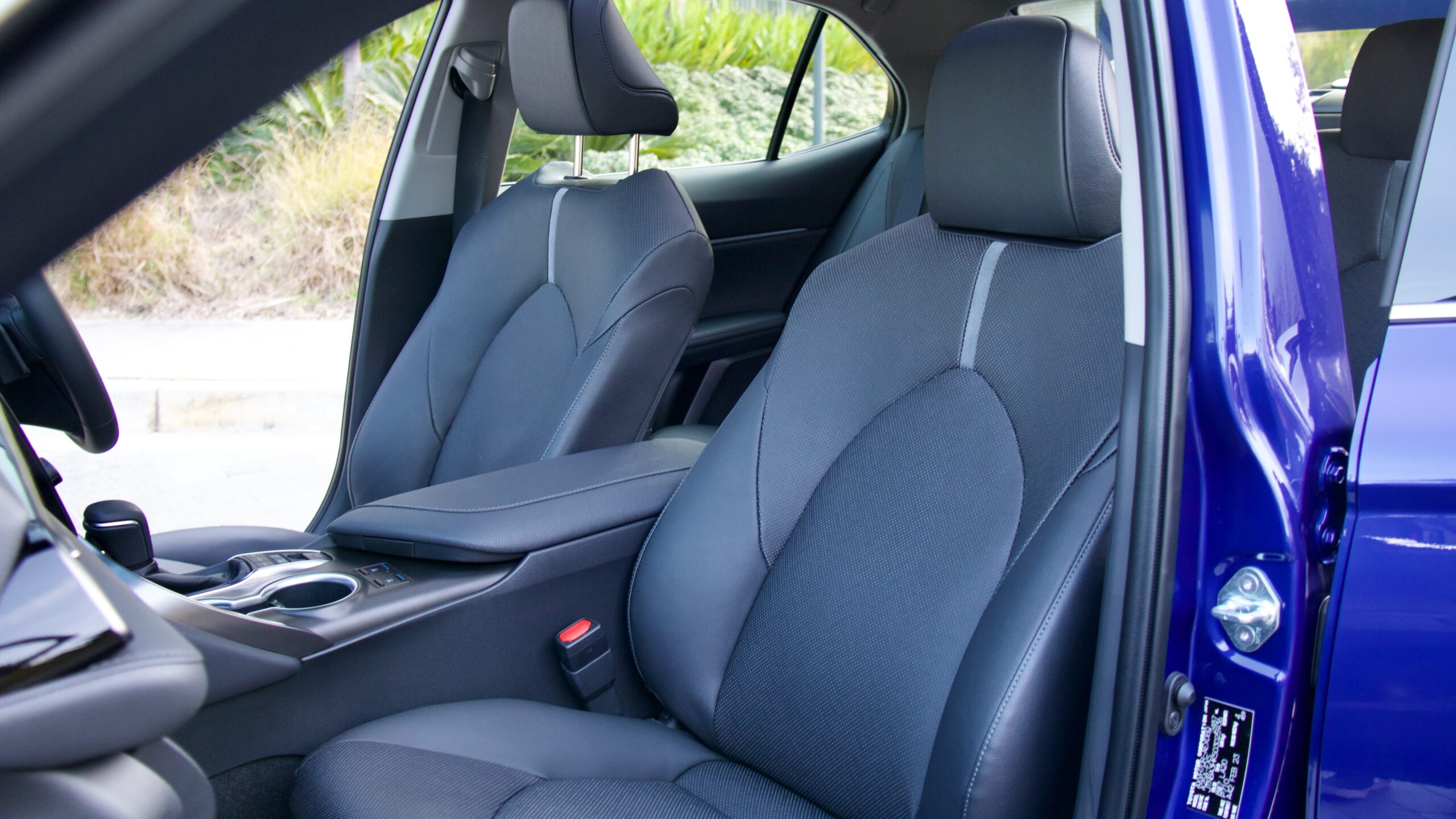
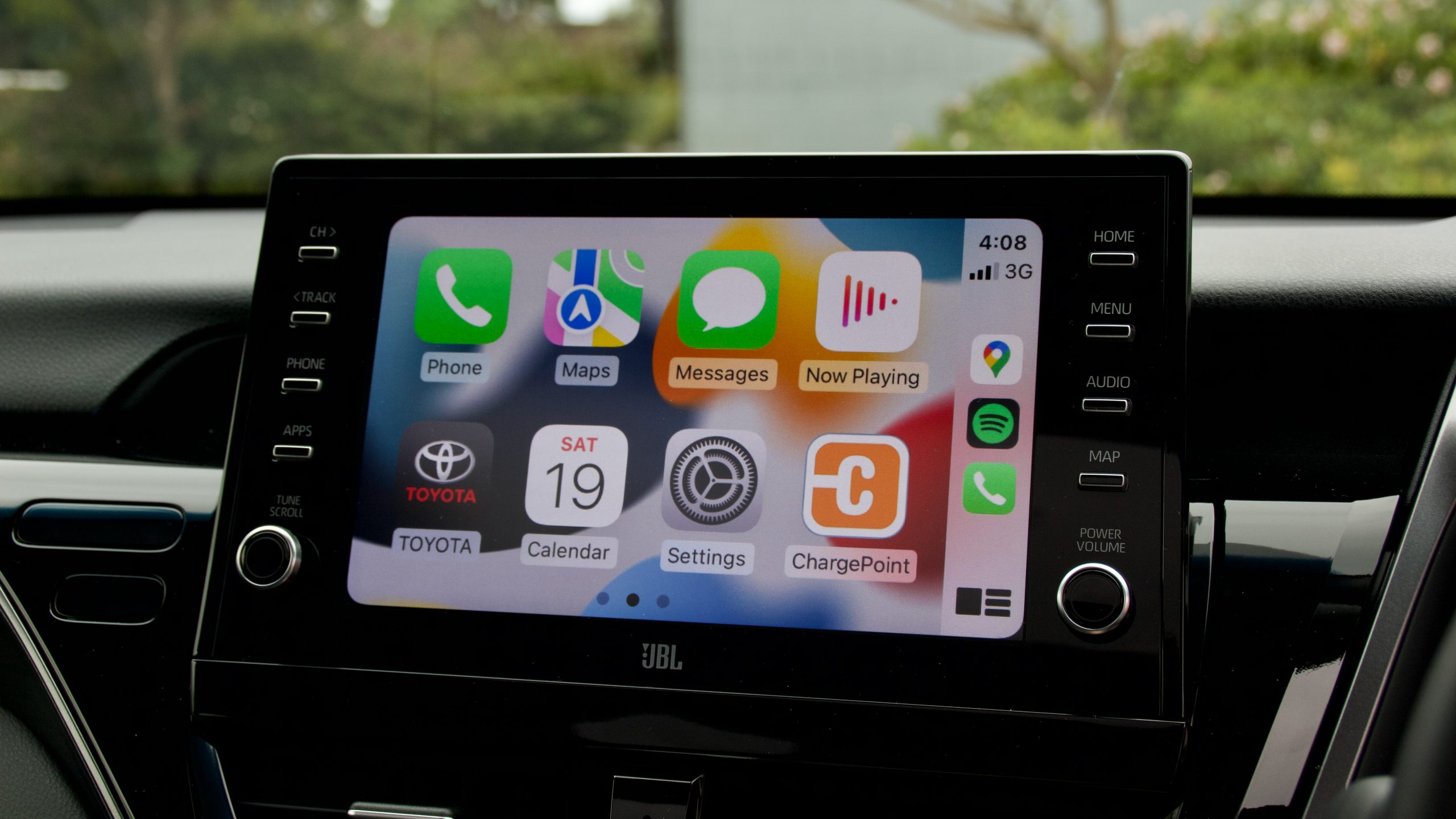
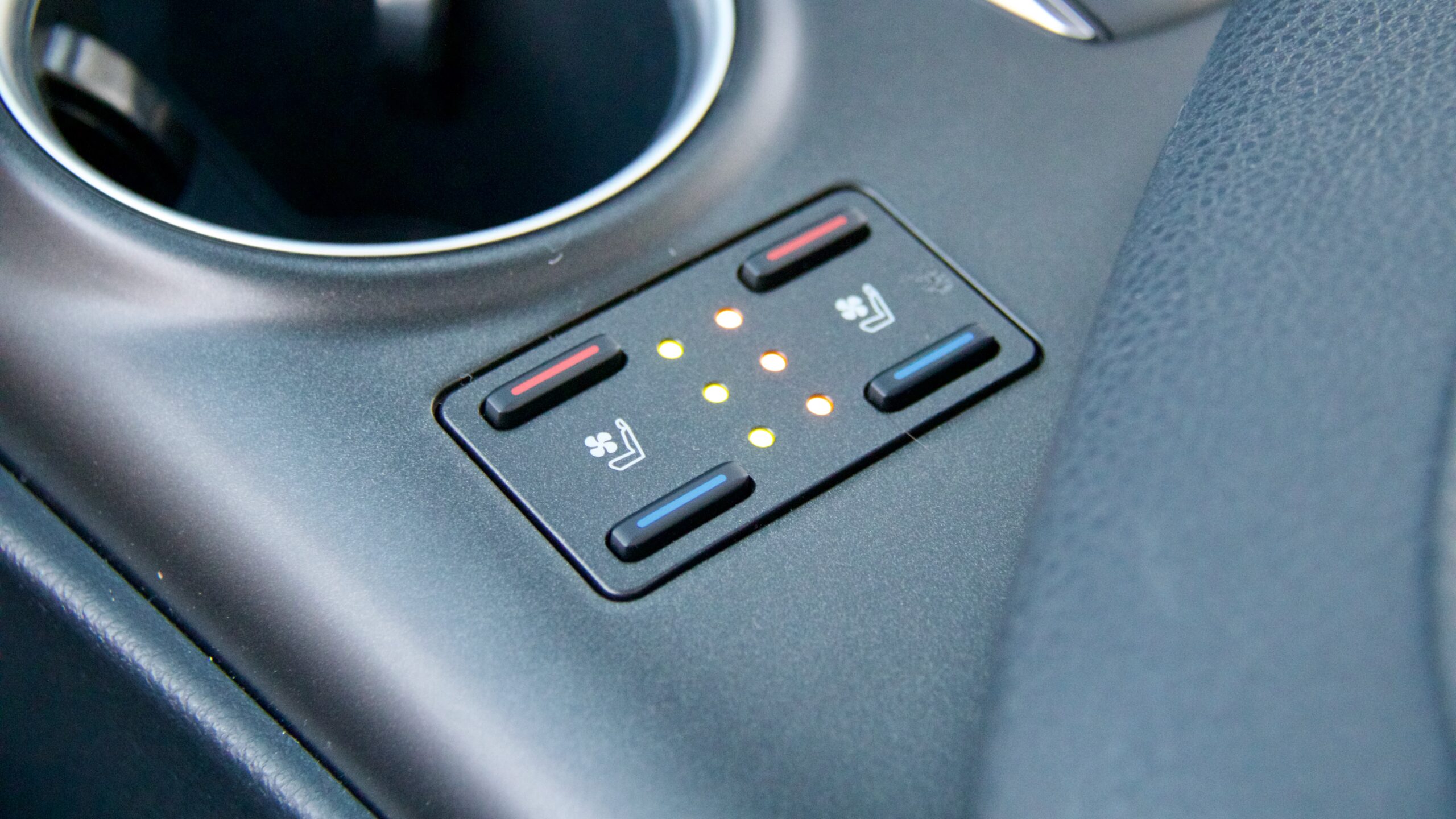
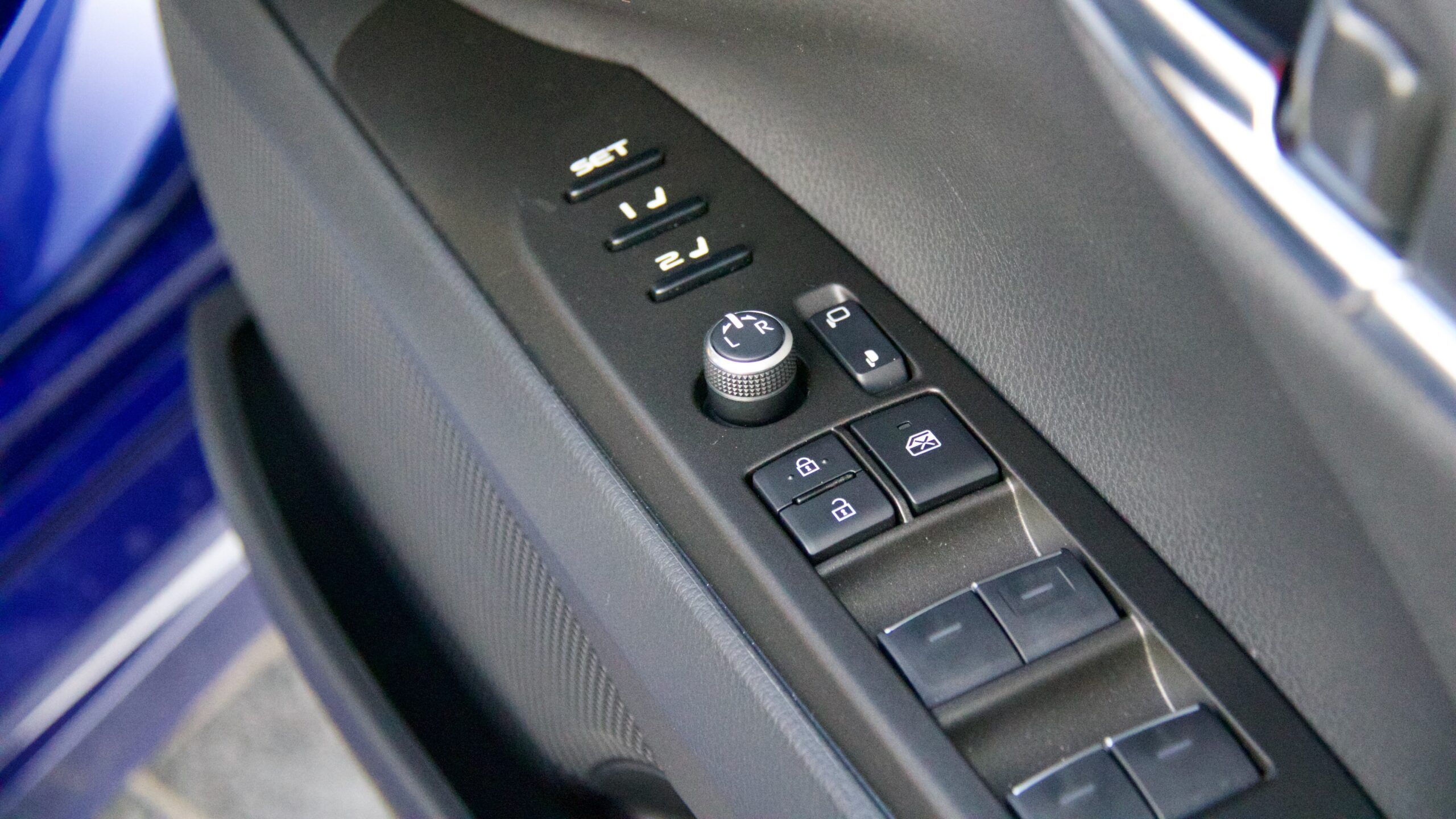
Ahead of the driver is a semi digital instrument cluster – a 7.0-inch screen, flanked by analog dials on each side which does the job and can display plenty of useful data, but again feels dated – along with the infotainment screen, it drags down the ambience of the interior – a fully digital display as in other facelift/new Toyota models would have been great addition. Still the driver’s head-up display is good and allows the driver to monitor their speed with less distraction.
The second row of the 2023 Toyota Camry SL Hybrid is a roomy and pleasant place to be. Two adults can sit in comfort on the two outbound seats – a third can sit in the centre at a pinch, though children and teens would be more comfortable there. The outbound seats feature generous head, knee and leg room. In terms of rear seat facilities, there are two map pockets, two USB charging points, door bins and a fold down armrest. Unfortunately, rear passengers miss out on the luxuries offered on some overseas Camry models, including heated seats, a separate climate control zone and a powered rear window shade.
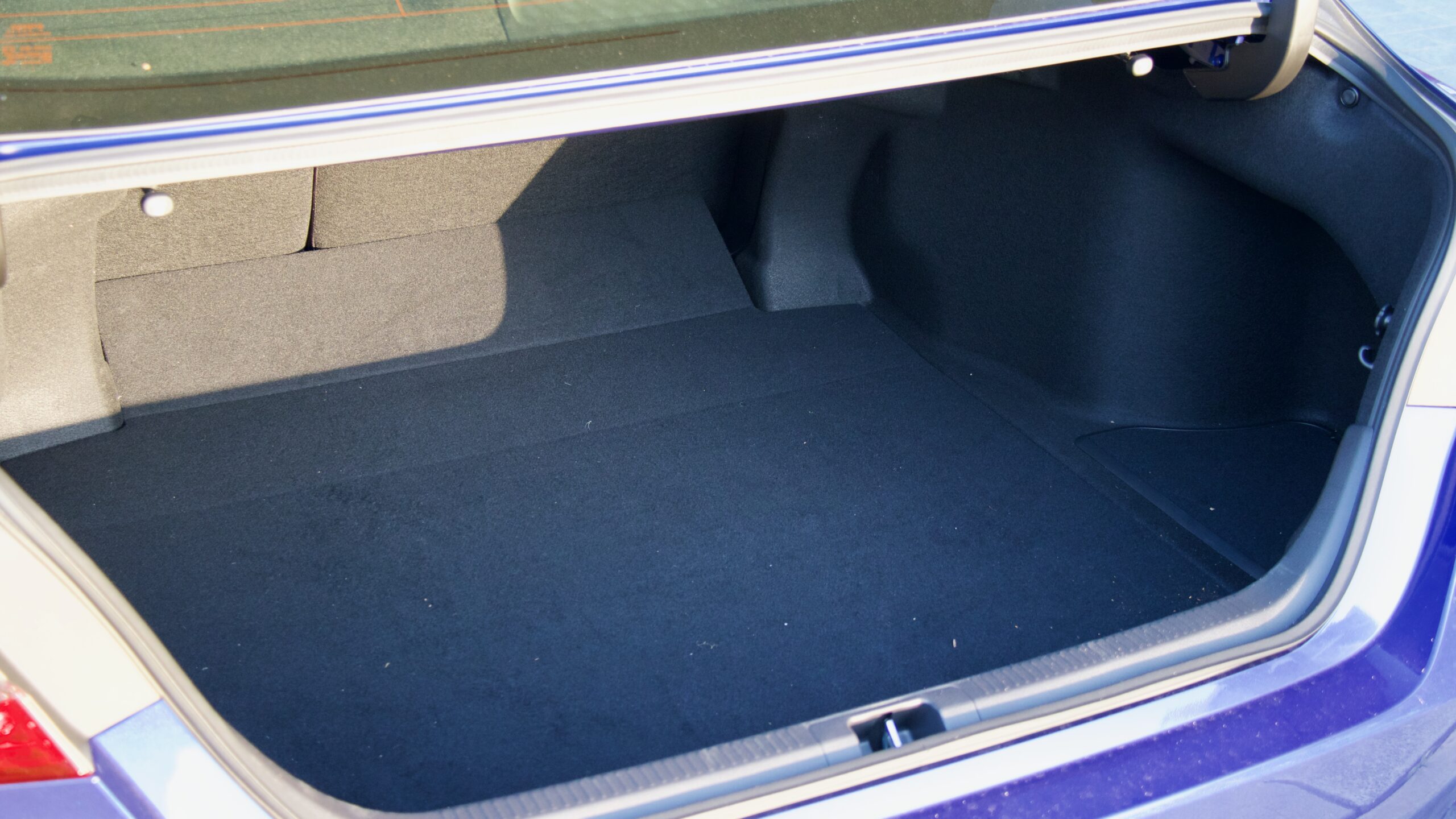
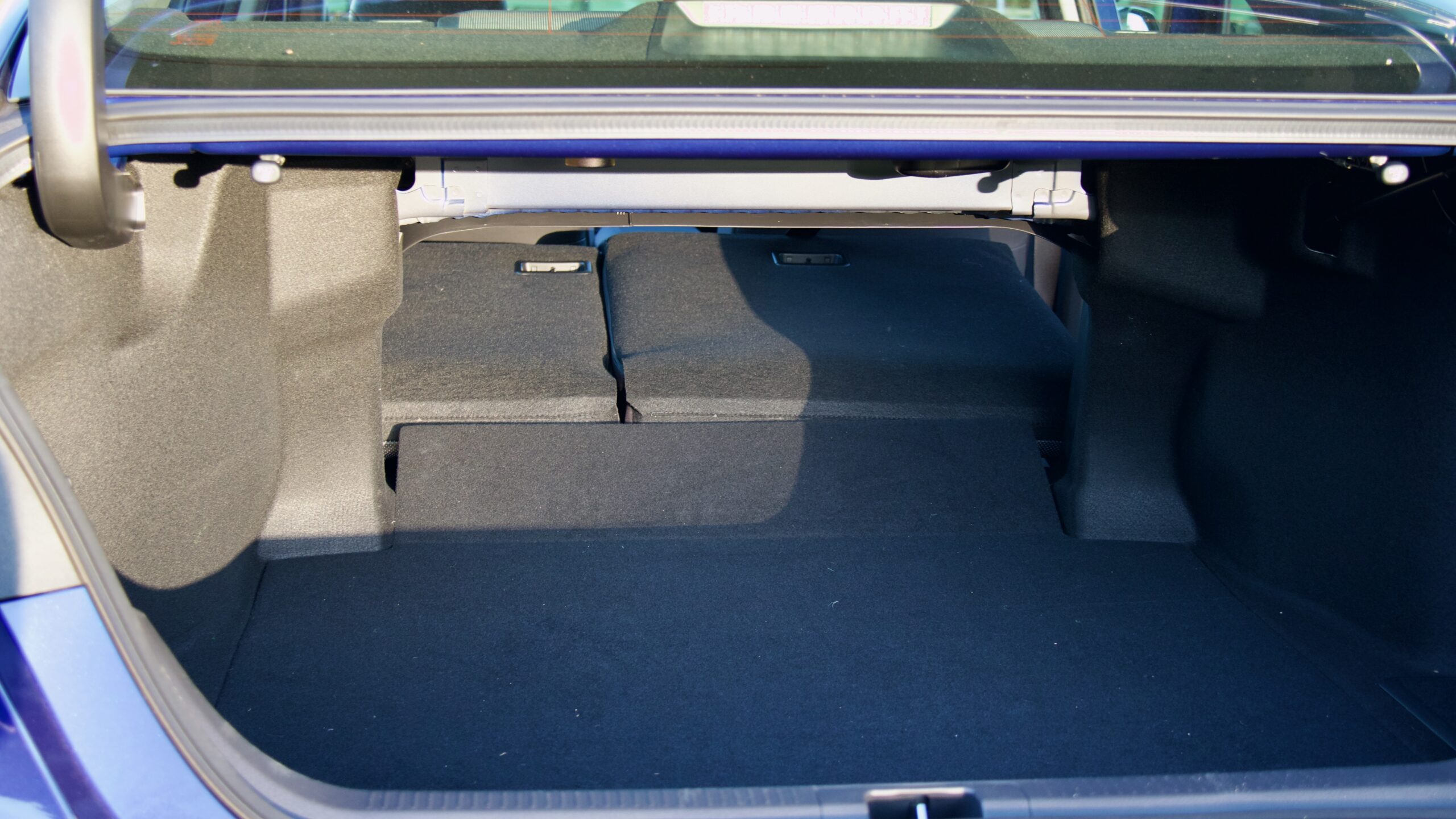
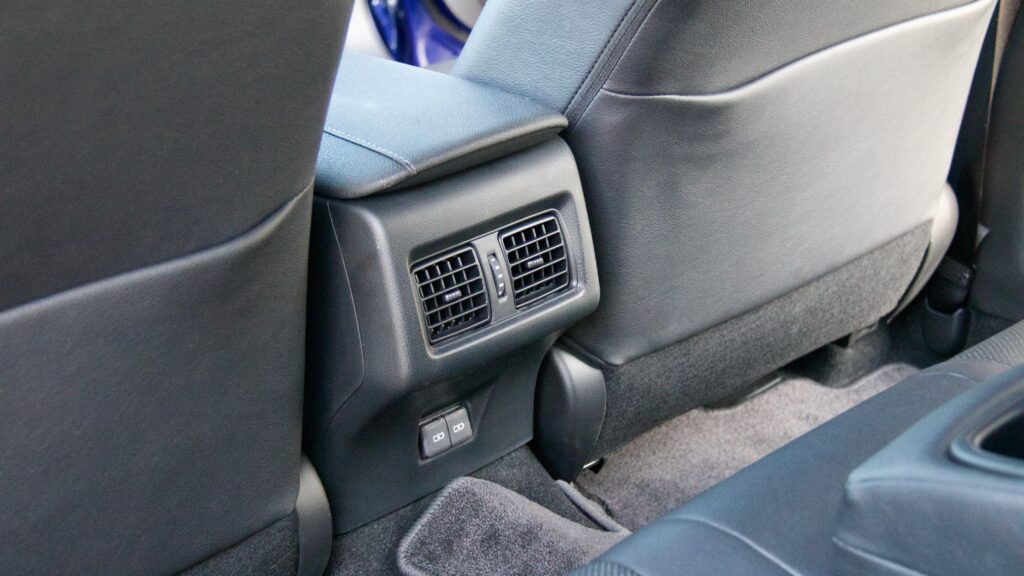
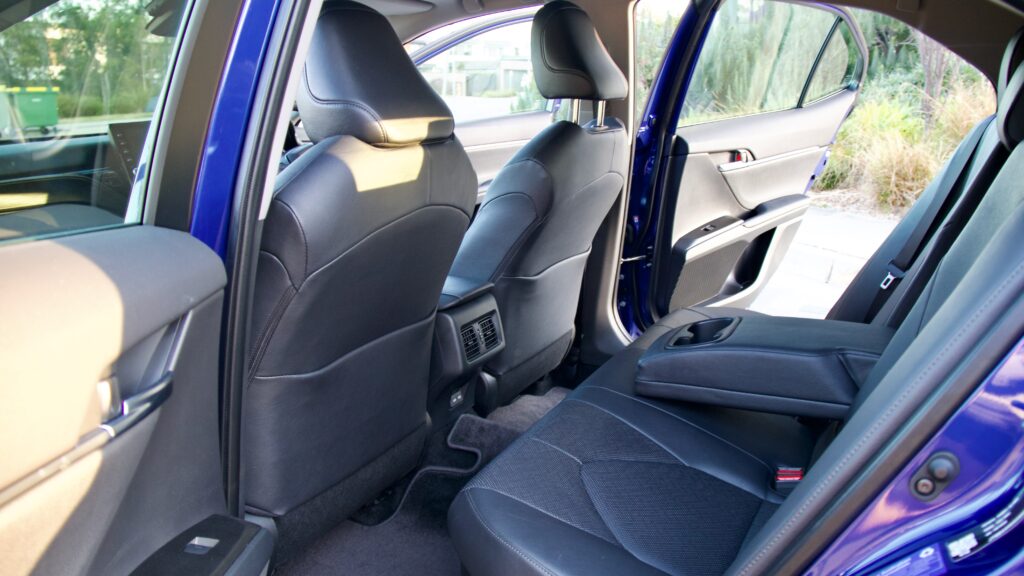
The power opening bootlid opens to a 524 litre space – the Accord does have a larger boot at 570L, but the space in the Camry is still large. The rear seats fold to transport longer items and there are hooks for bags, but there isn’t too much else in terms of features. Under the boot floor is a space saver spare – we’d rather a full sized spare (or the option for one), but any type of spare is good in 2024!
How much does the 2023 Toyota Camry SL Hybrid cost to run?
Toyota covers the Camry with a five-year/unlimited kilometre warranty. A further two years’ of drivetrain coverage (for a total of seven) is applied to Camry which have been serviced as per the logbook requirements, and Toyota gives an 5 years of hybrid battery coverage (for a total of 10 years) for Camrys which have had an annual hybrid battery check. During its runout sale, Honda is besting Toyota by offering a seven-year warranty for the Accord, though there is no additional battery coverage to match Toyota – plus, when the promotion ends, the warranty offered will revert to the standard Honda five-year/ unlimited kilometre warranty.
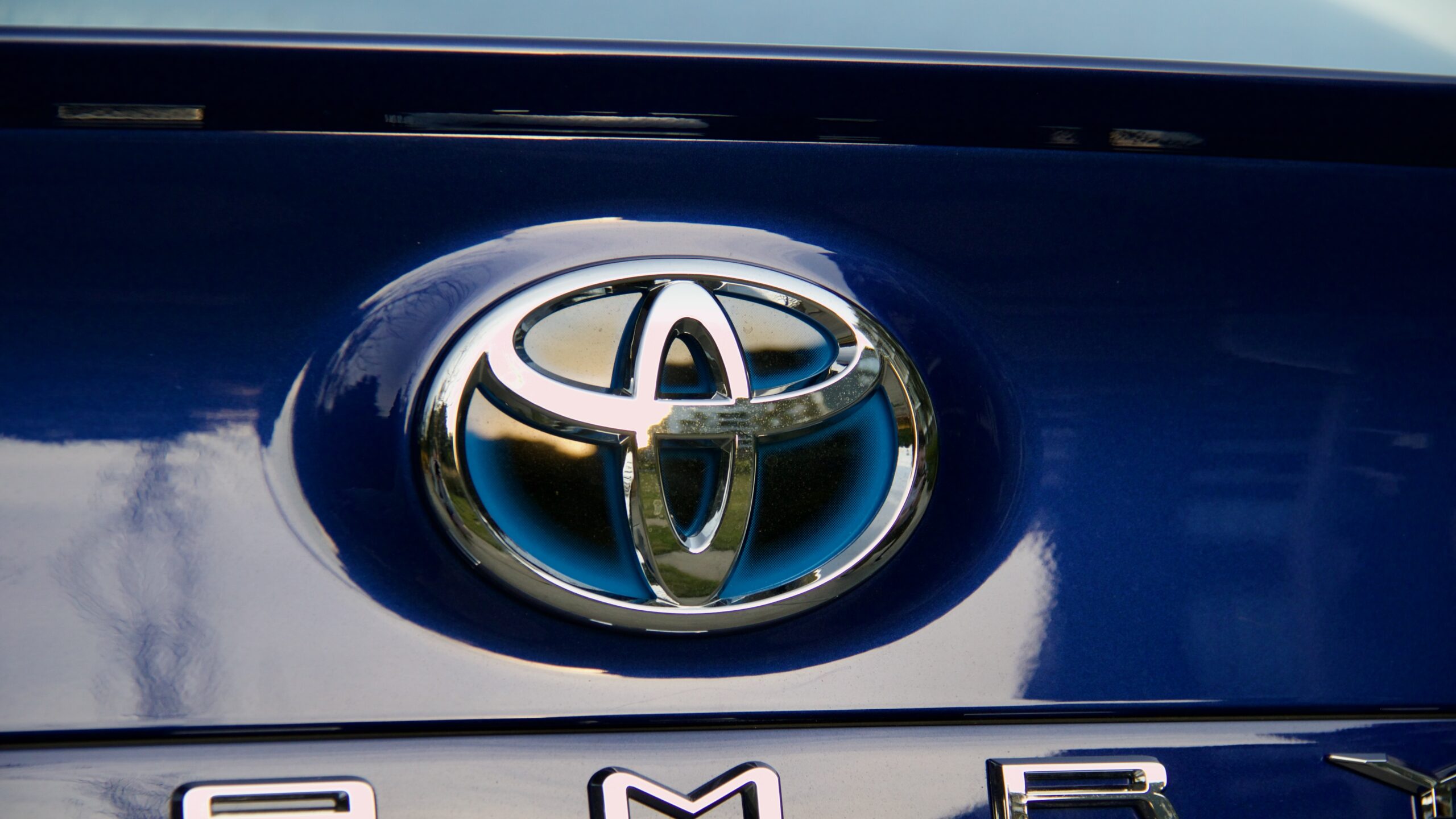
With 15,000km/12-month service intervals, servicing the Camry over the first five years (or 75,000kms) costs a low $1,275, which compared to most cars is cheap, however Honda beats this servicing over the first 5 years (albeit at a lower 60,000kms) costs $995 – the downside is the shorter 10,000km serval interval – meaning those who do higher kilometres in an Accord will pay more sooner for servicing. Toyota doesn’t include any roadside assistance with the Camry, however during the current Accord promotion, Honda includes seven years of roadside assistance with the Accord – normally five years is included.
Should I buy a 2023 Toyota Camry SL Hybrid?
This generation Camry was big news back in 2017 as it was one of the first vehicles under Toyota’s newfound focus on dynamics. Sure, the promise of engaging driving had been made on many generations of Camrys in the past, but this was the first time Toyota had actually delivered on their promise, and a testament to this is how well it still holds up seven years later. For the most part, despite being at the end of its run, this generation Camry has held up pretty well – it’s still impressively efficient, but also has more than enough power, it’s surprisingly dynamic, was priced fairly well and is pretty well equipped.
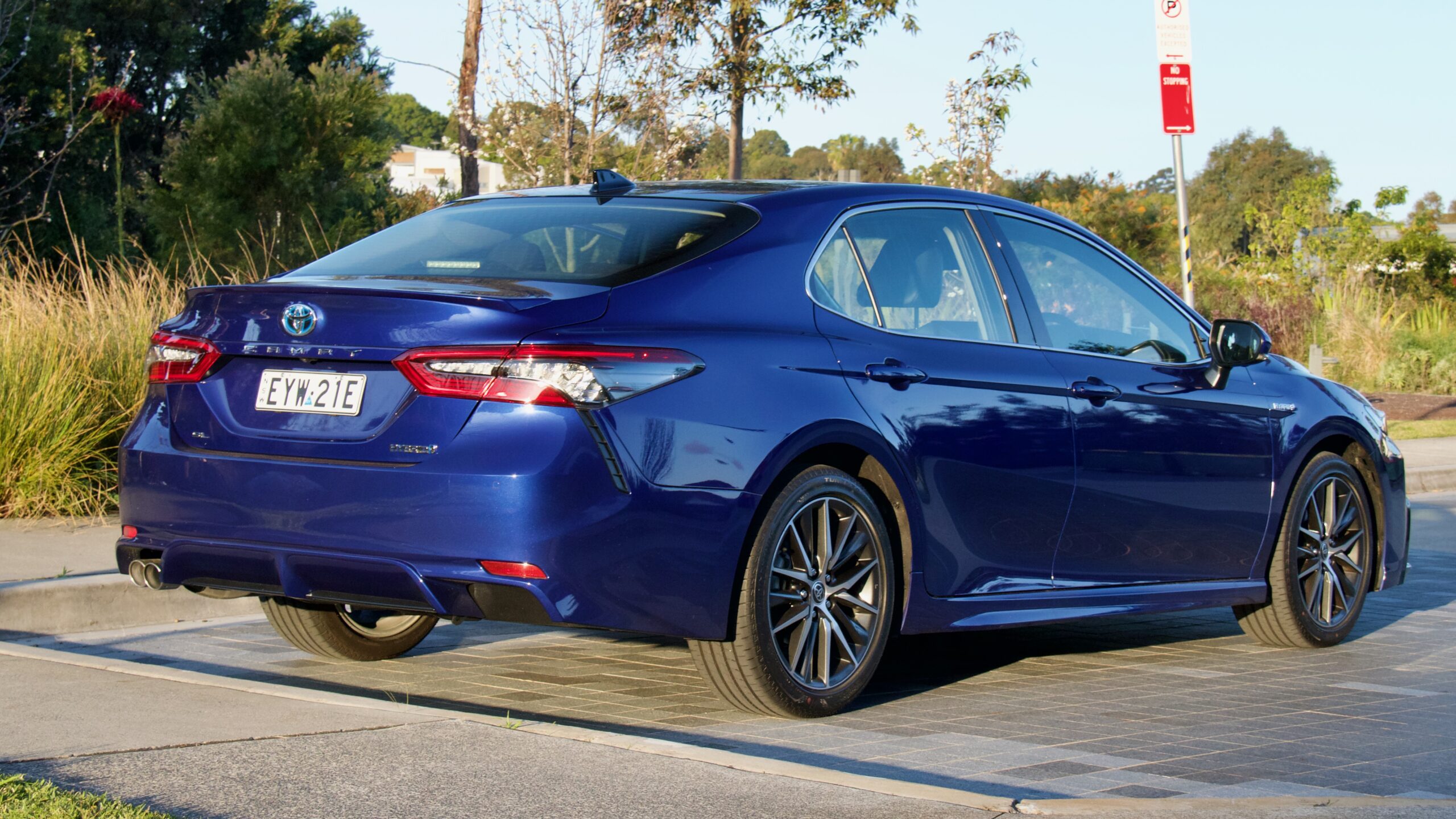
There aren’t too many bad things to say about the Camry – sure some won’t like the CVT drone under hard acceleration, it’s missing equipment that was offered on overseas Camrys and it’s not as affordable as it once was, but these are fairly minor quibbles. We think the Camry’s biggest weakness is interior tech – the infotainment system and instrument cluster are probably the two elements that date it the most. We wish Toyota had done an update which brought the updated tech seen in the Corolla, RAV4 and Kluger to the Camry, as it’s done wonders for modernising the tech experience in those cars. Is the 2023 model Camry worth it? We’d say yes – unless the tech niggles are going to bother you, then we think most people would be quite happy with a 2023 Toyota Camry SL Hybrid.
Discover more: our news article on Toyota’s announcement of the 2024 Camry.
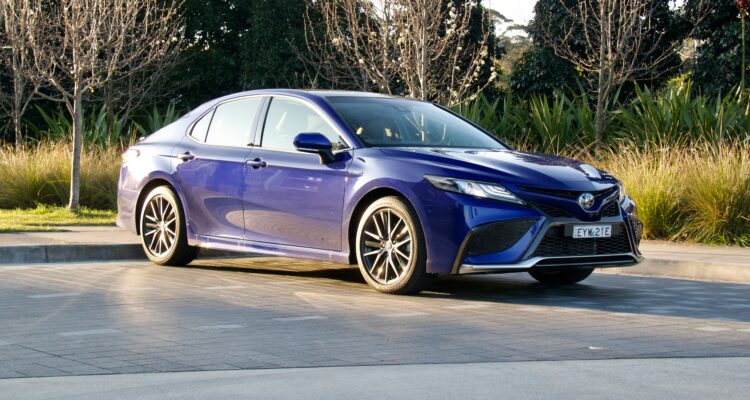
Leave a Reply